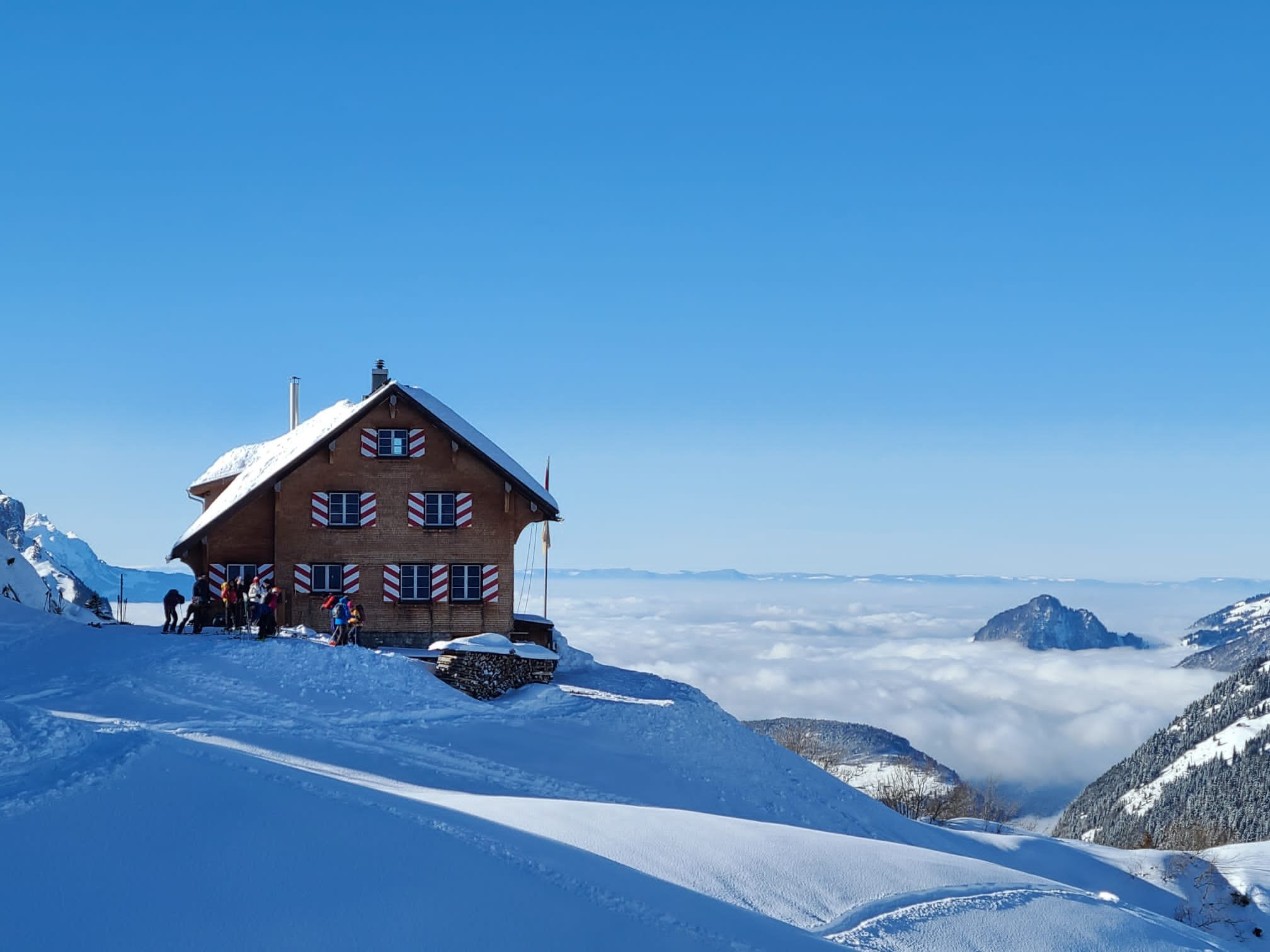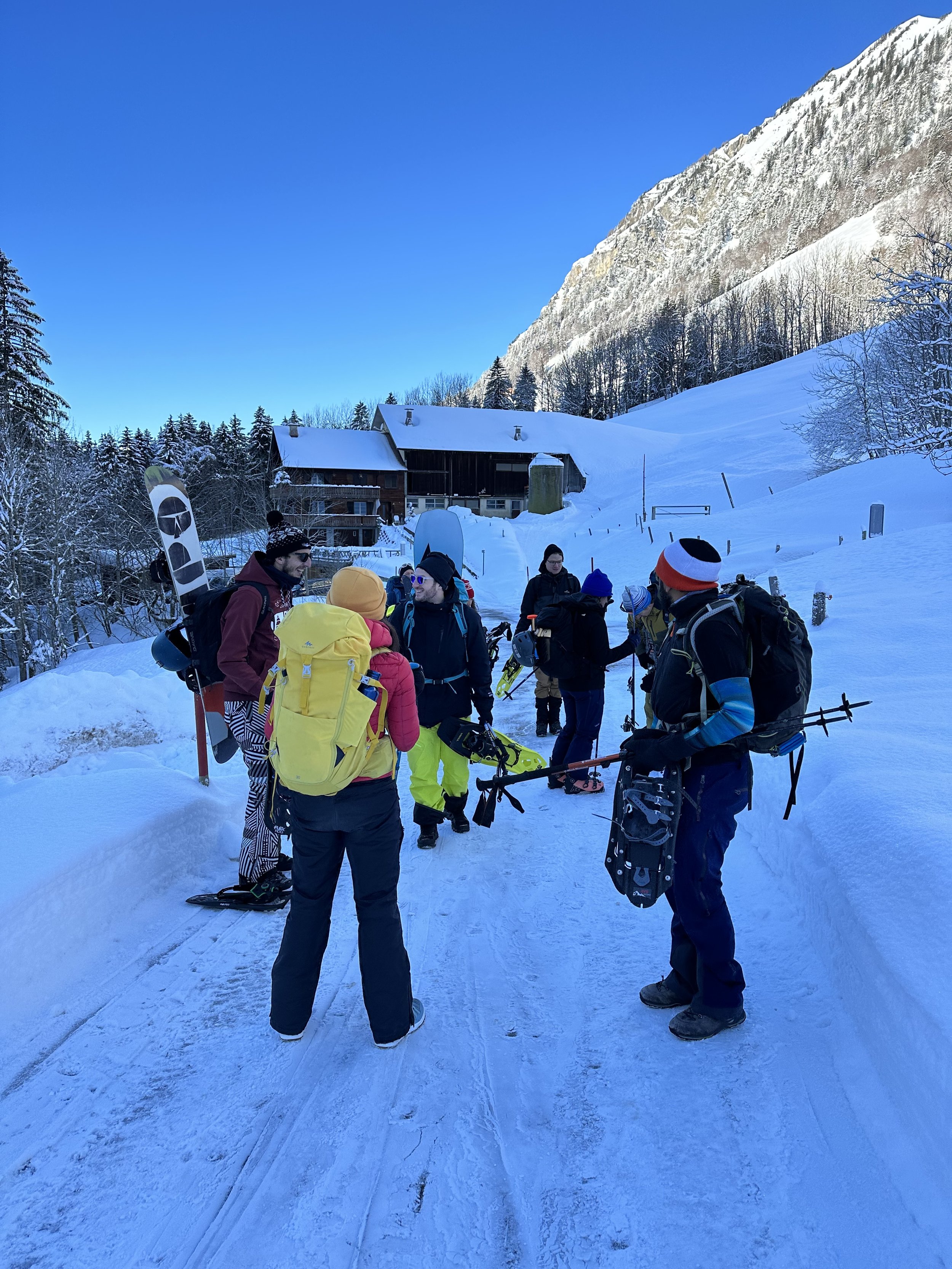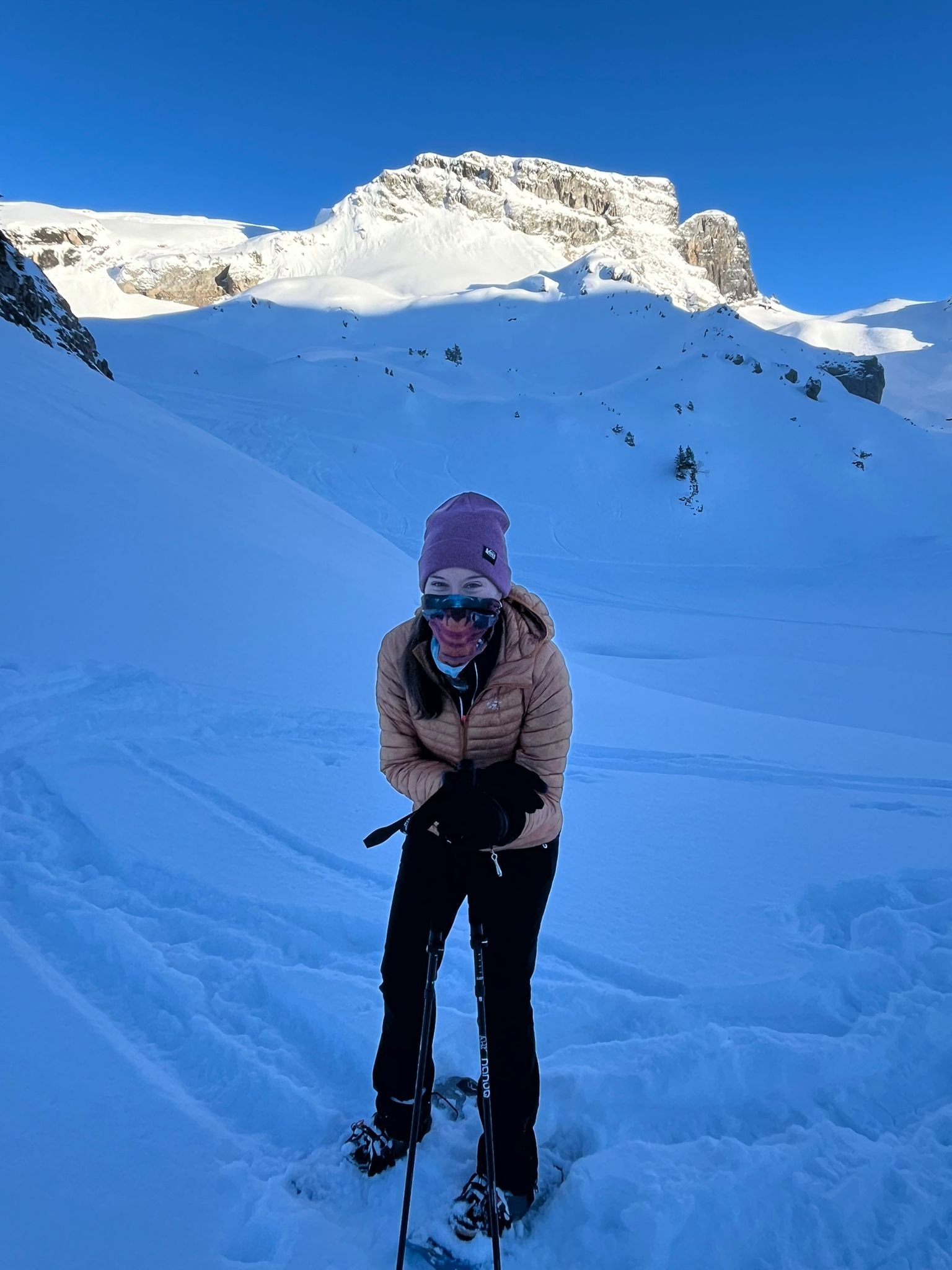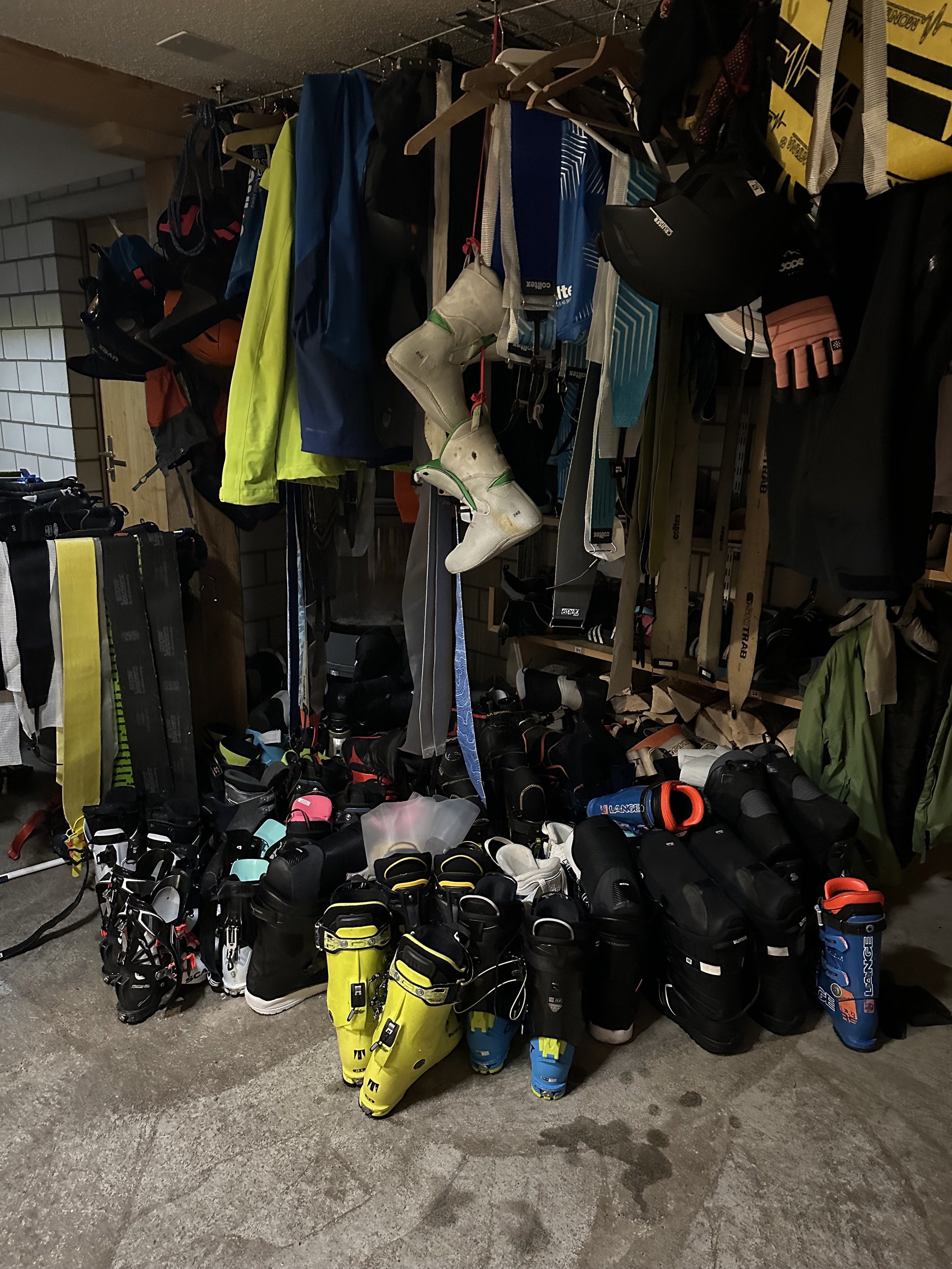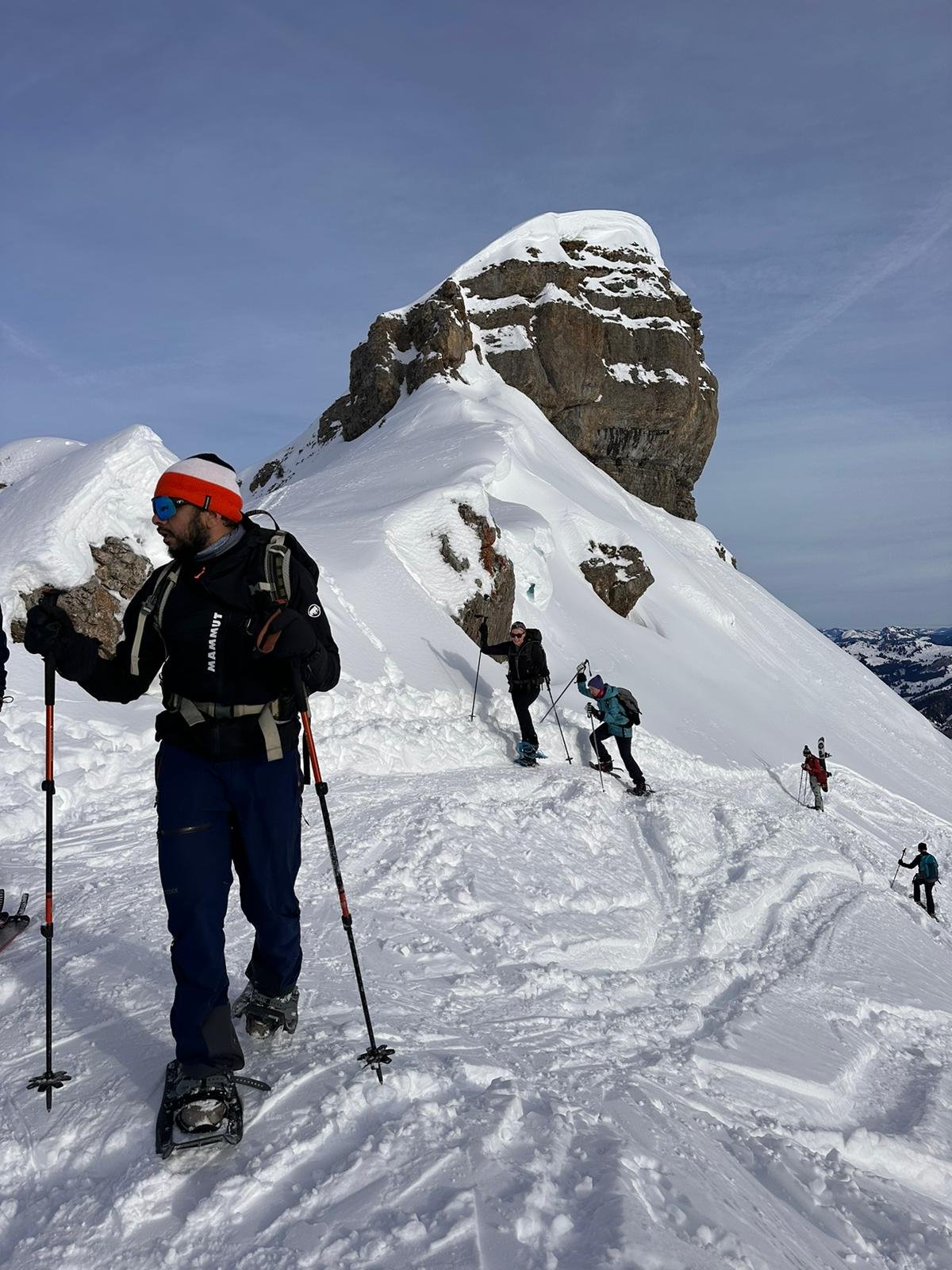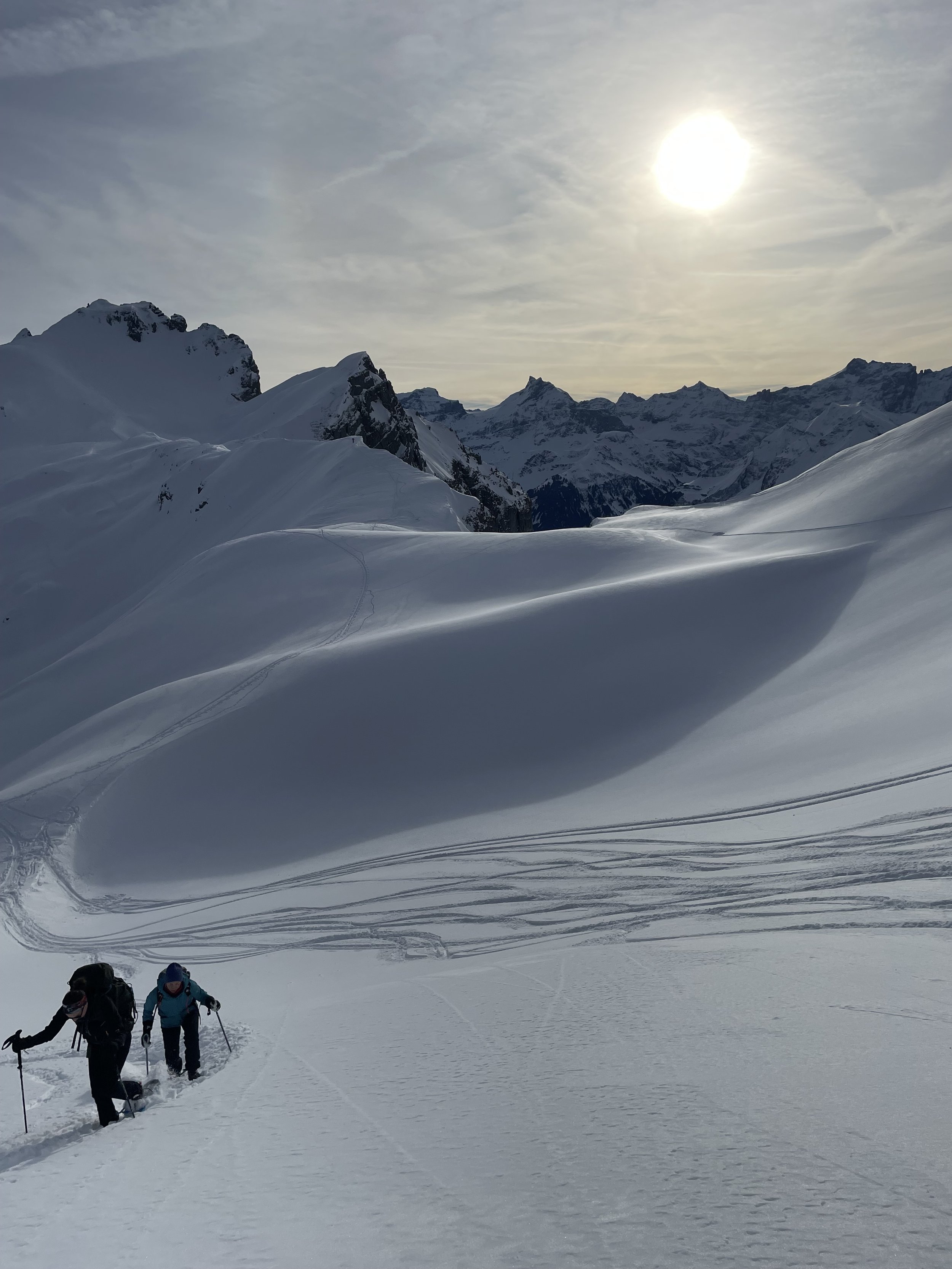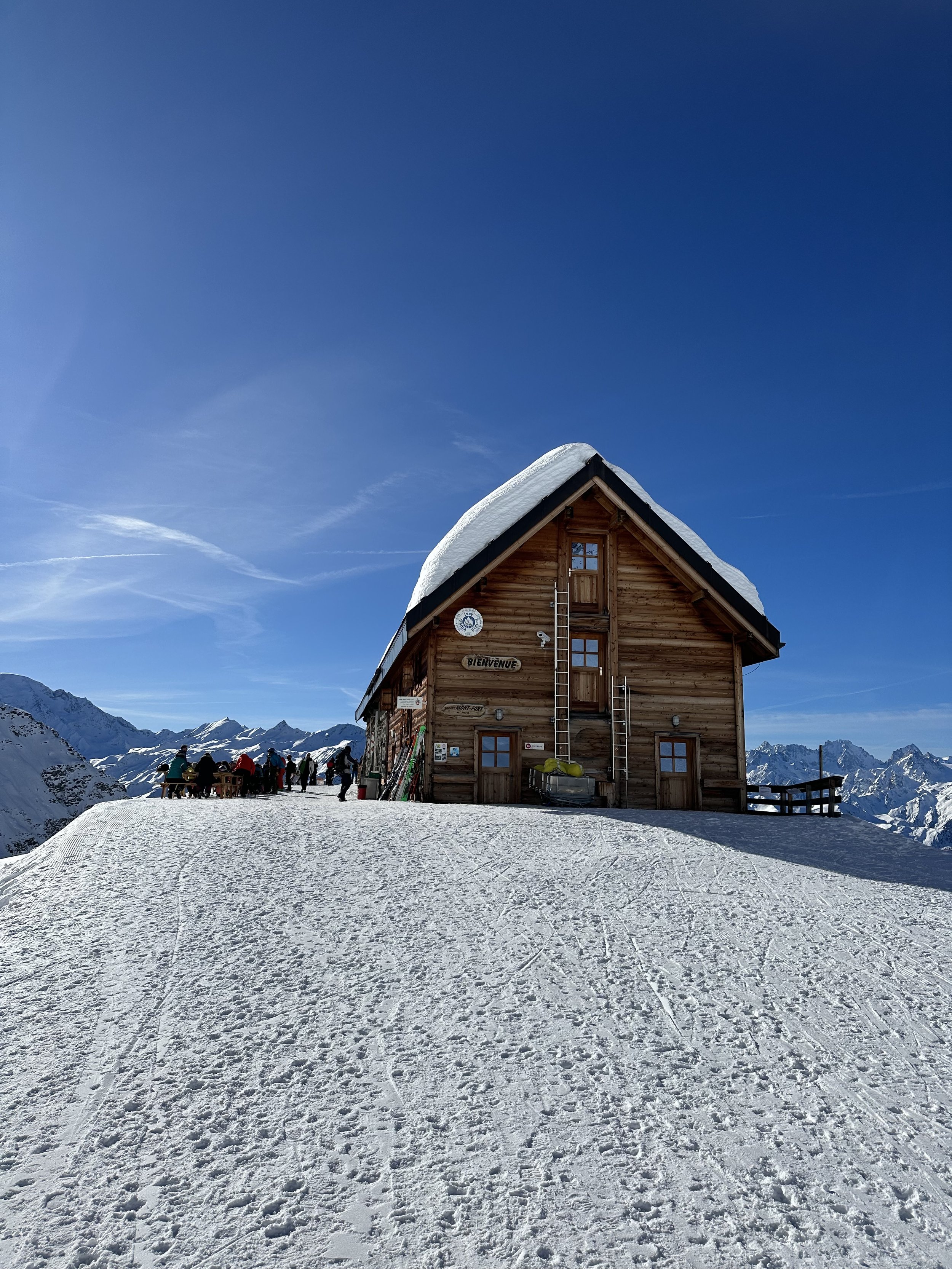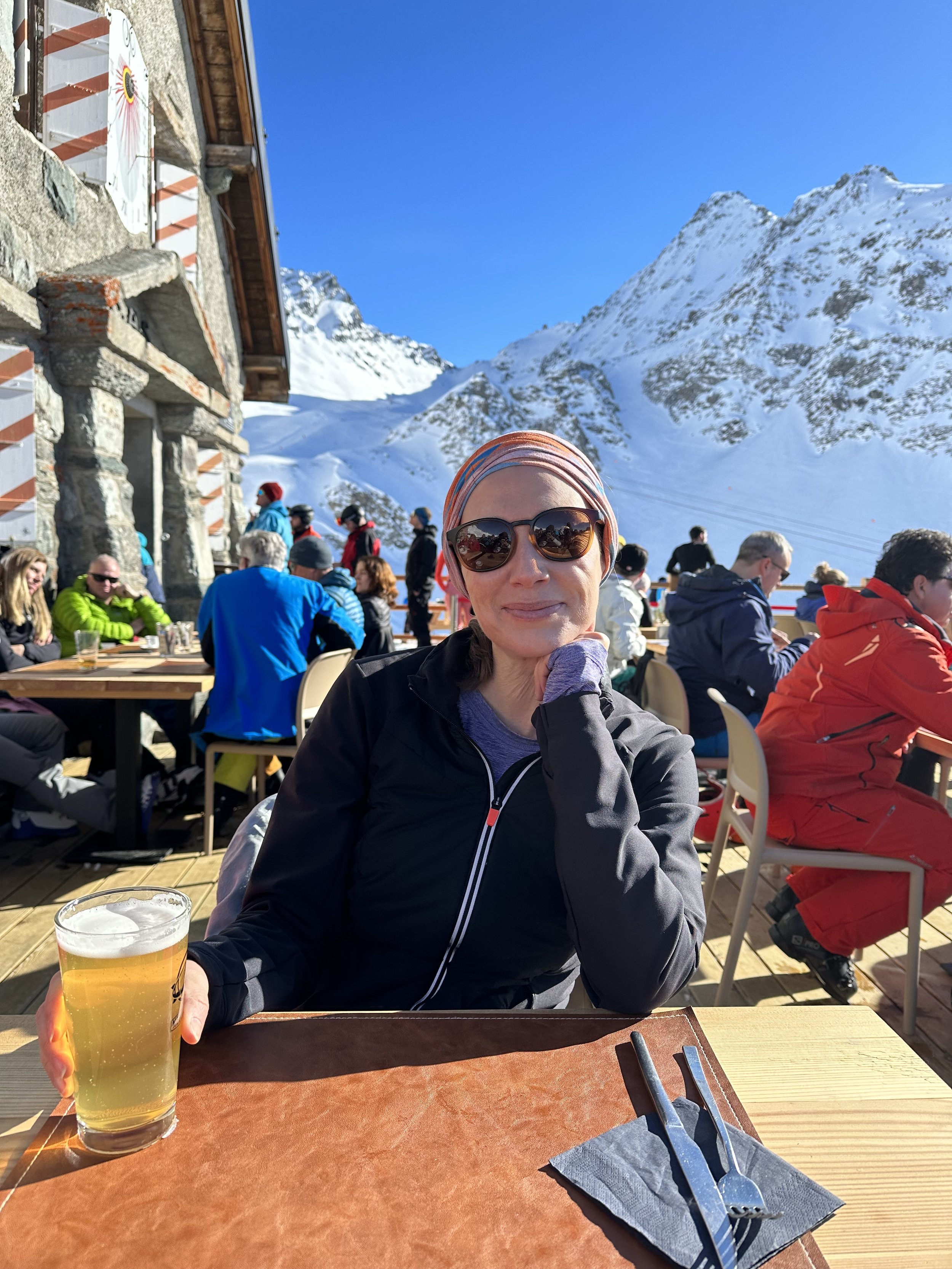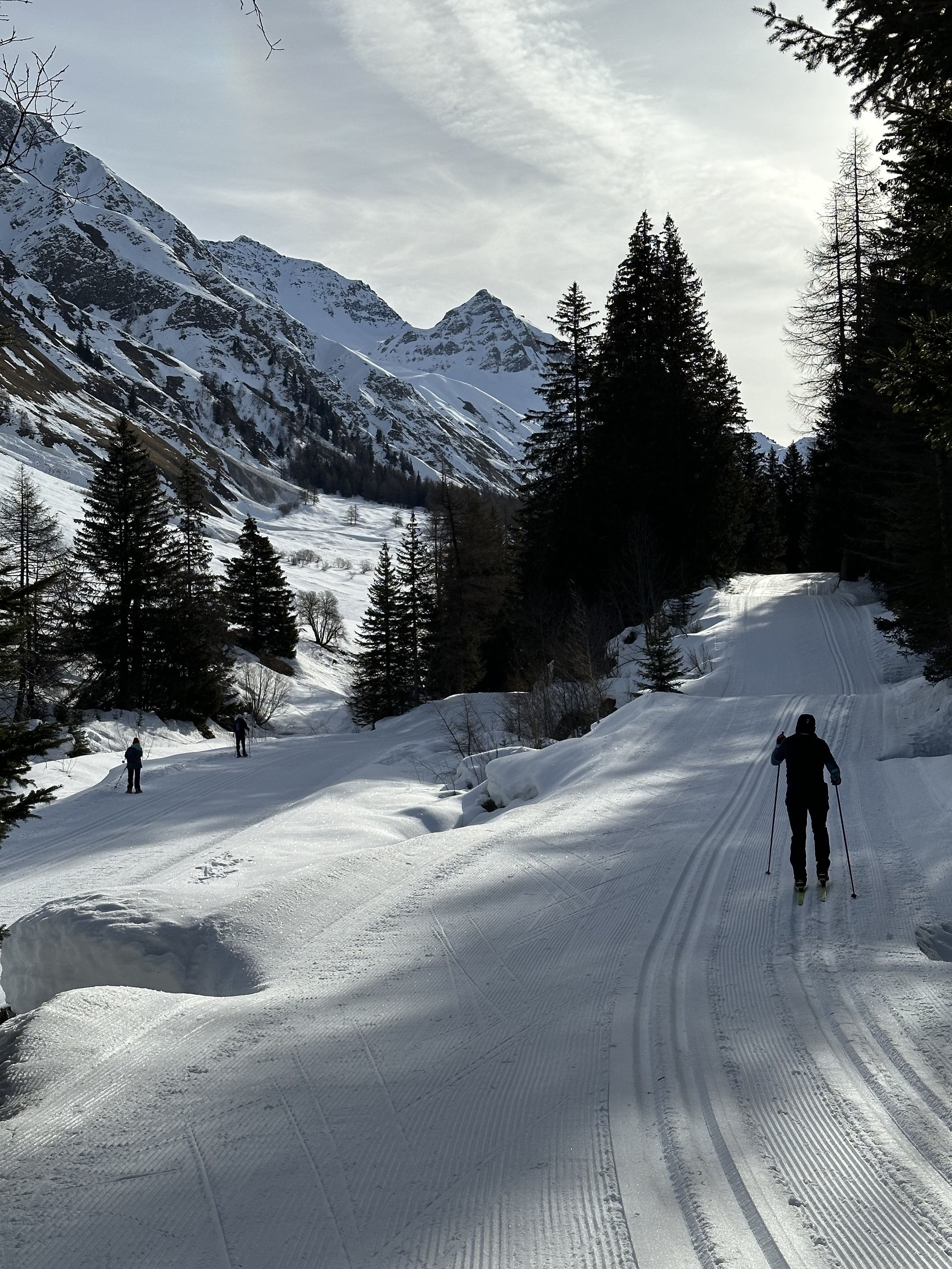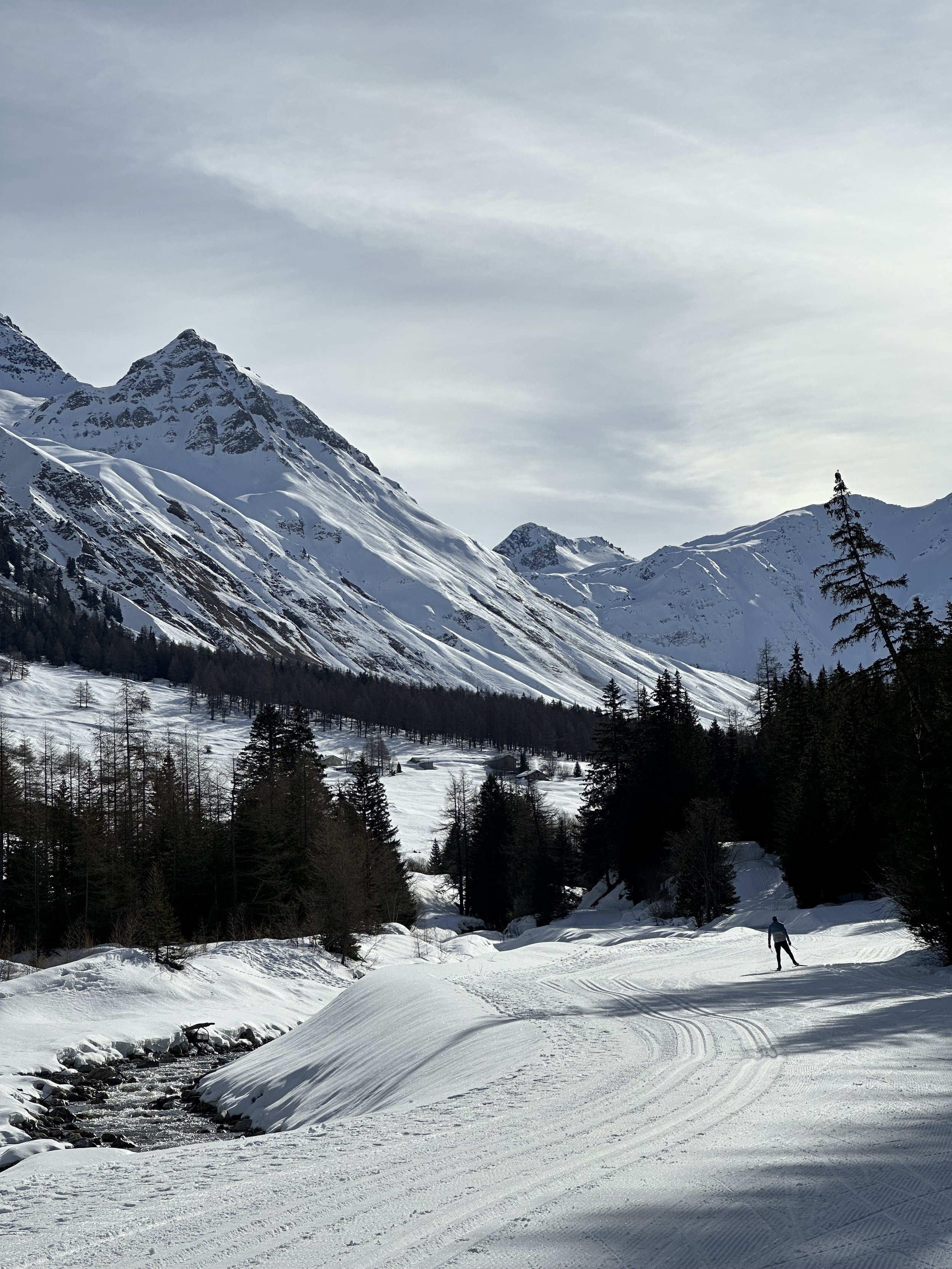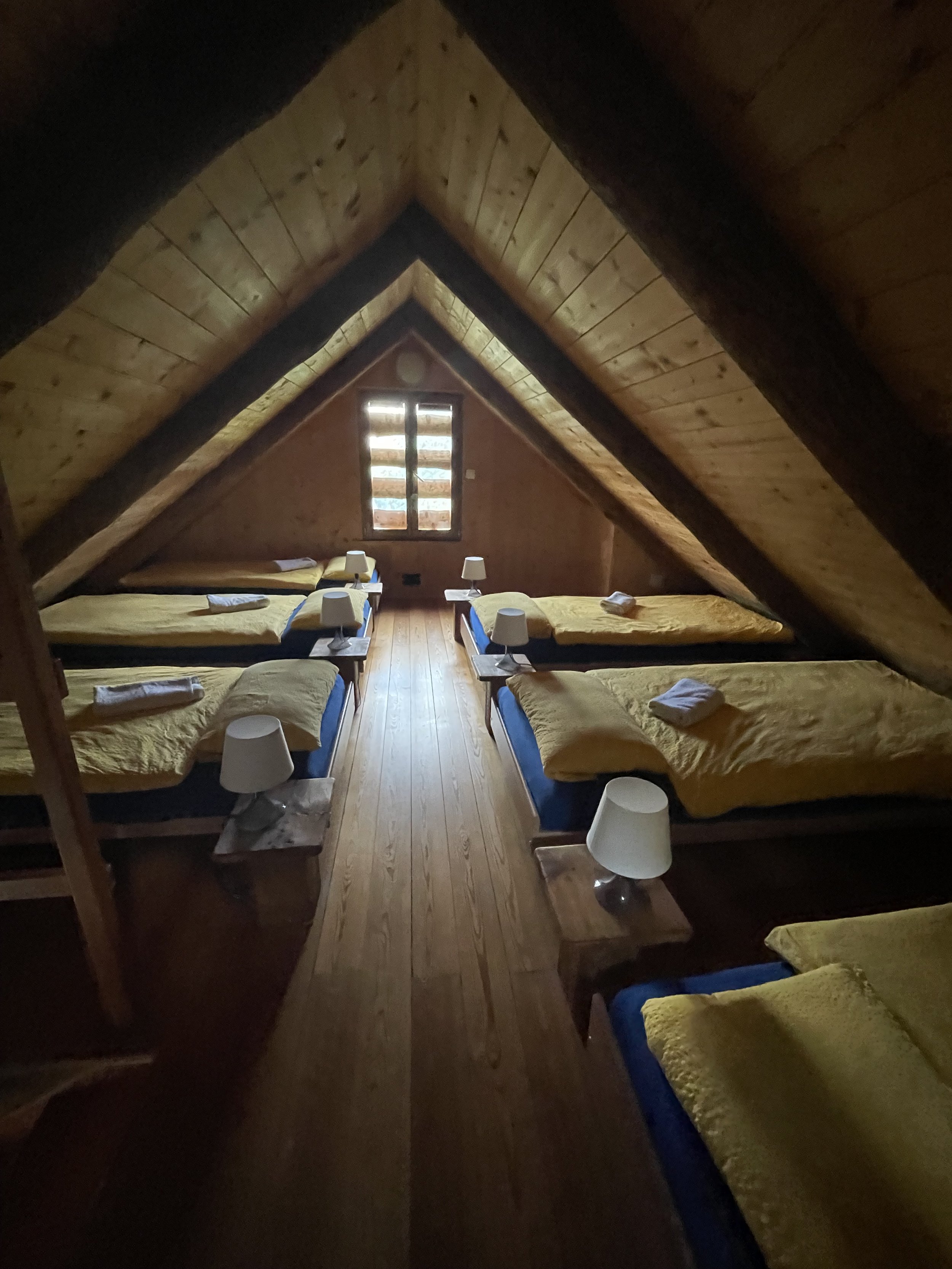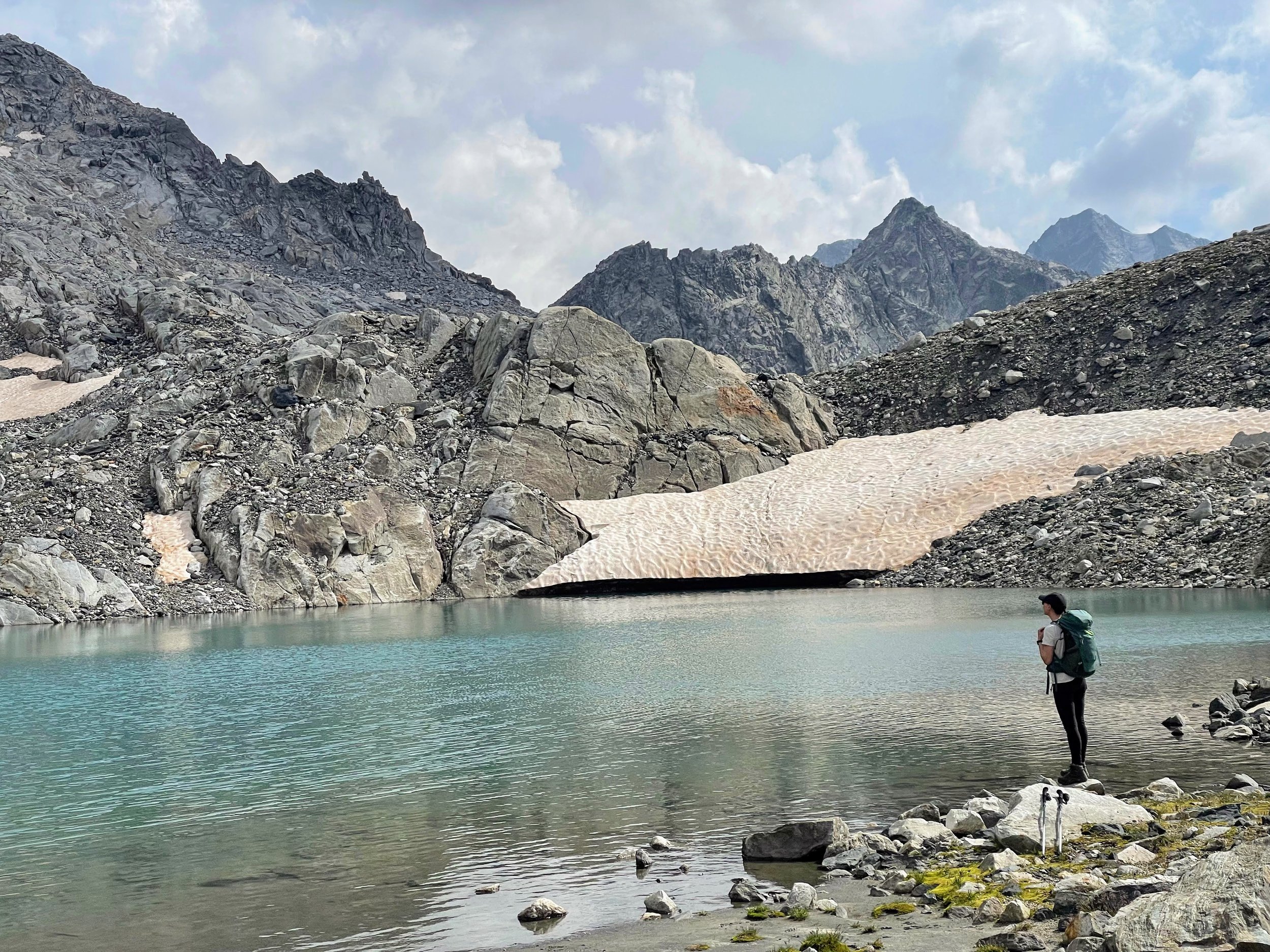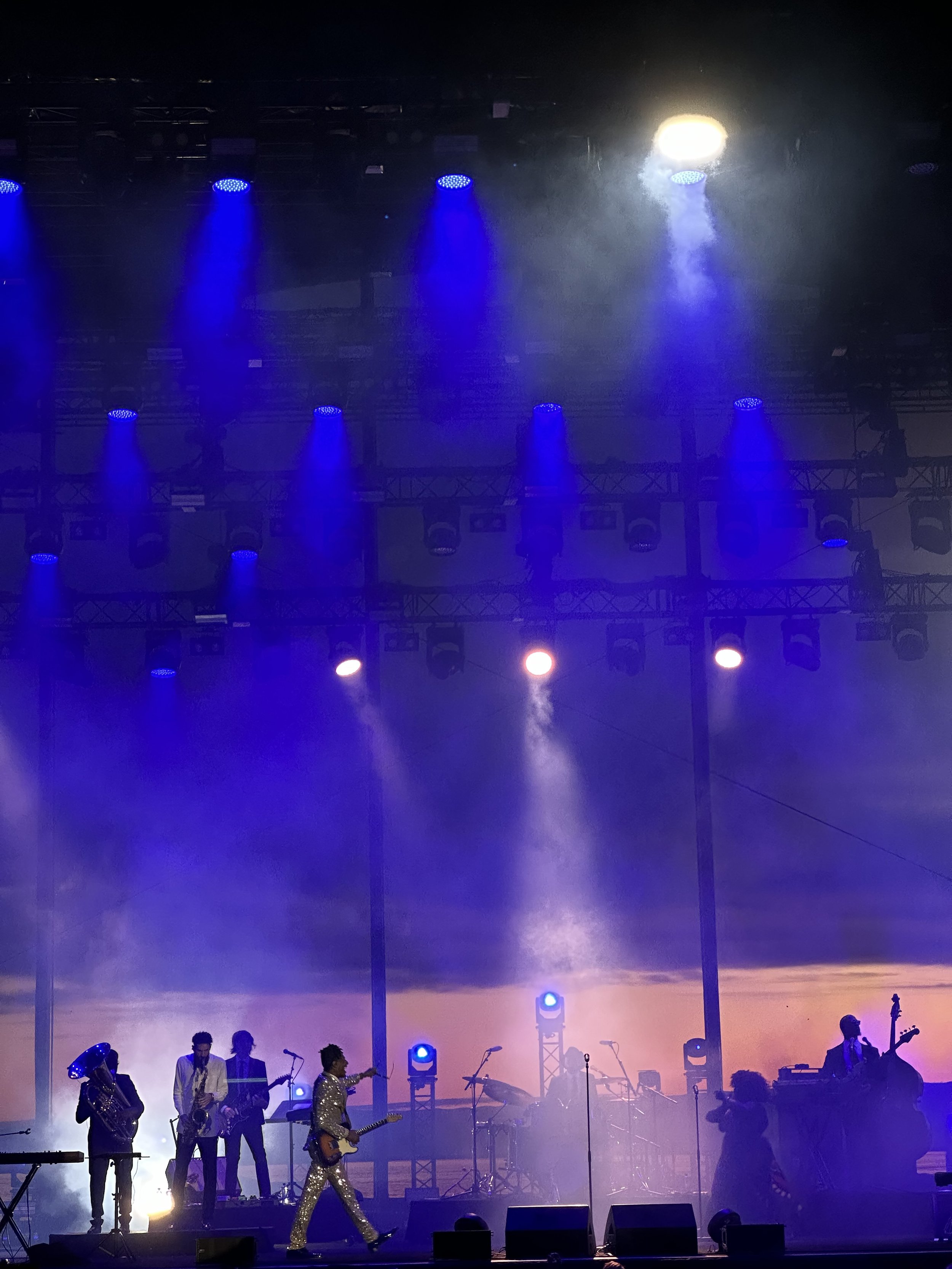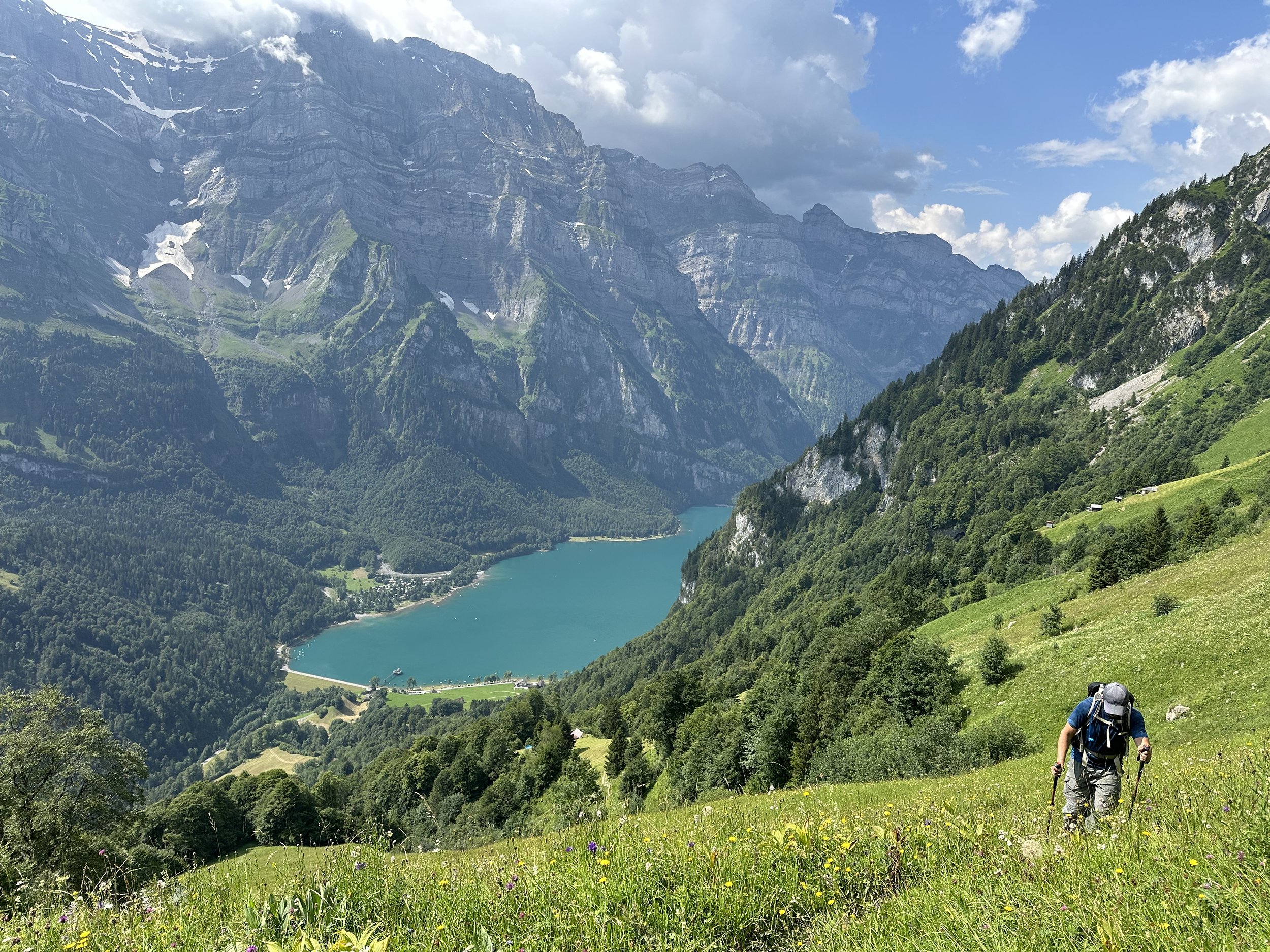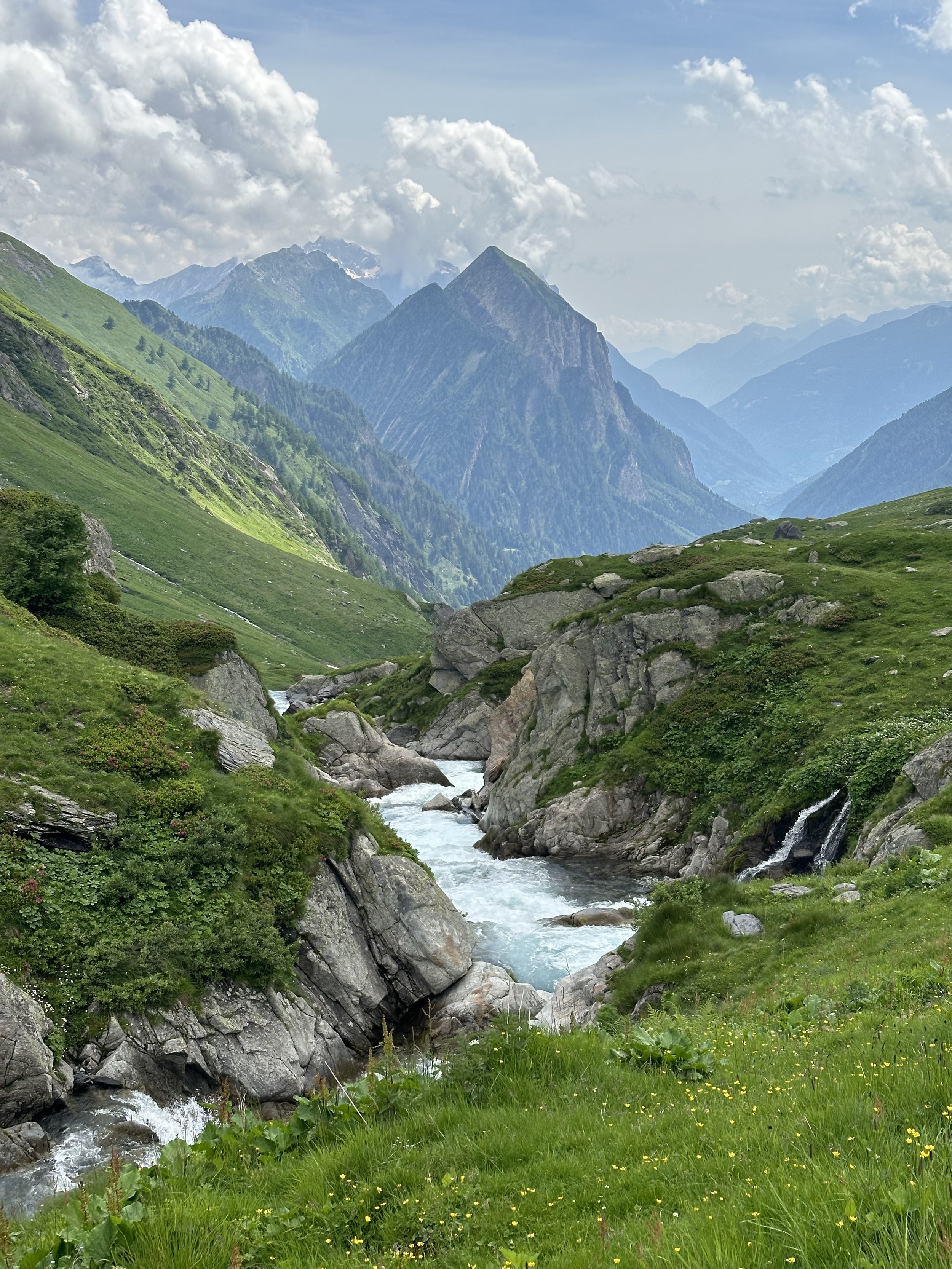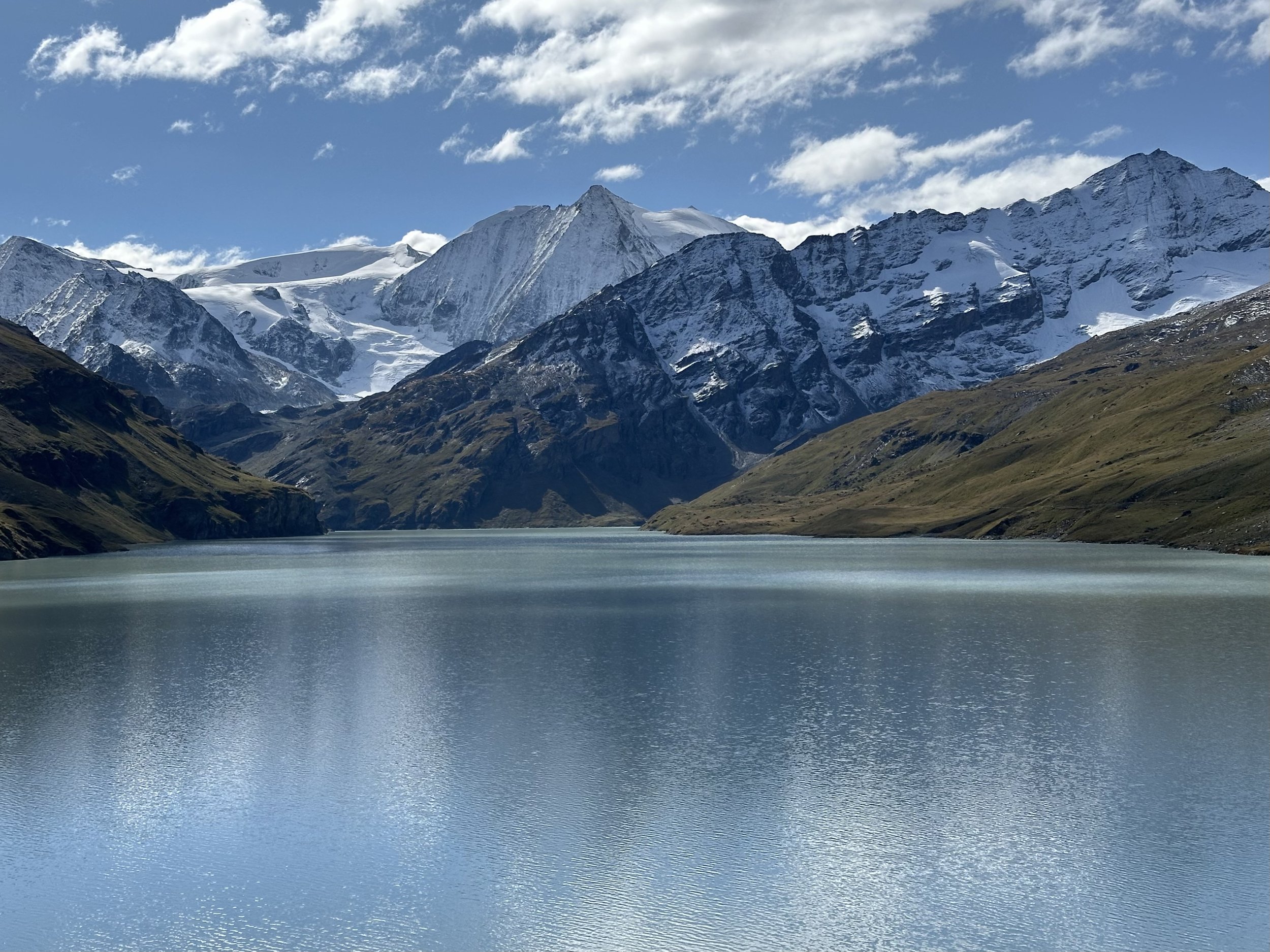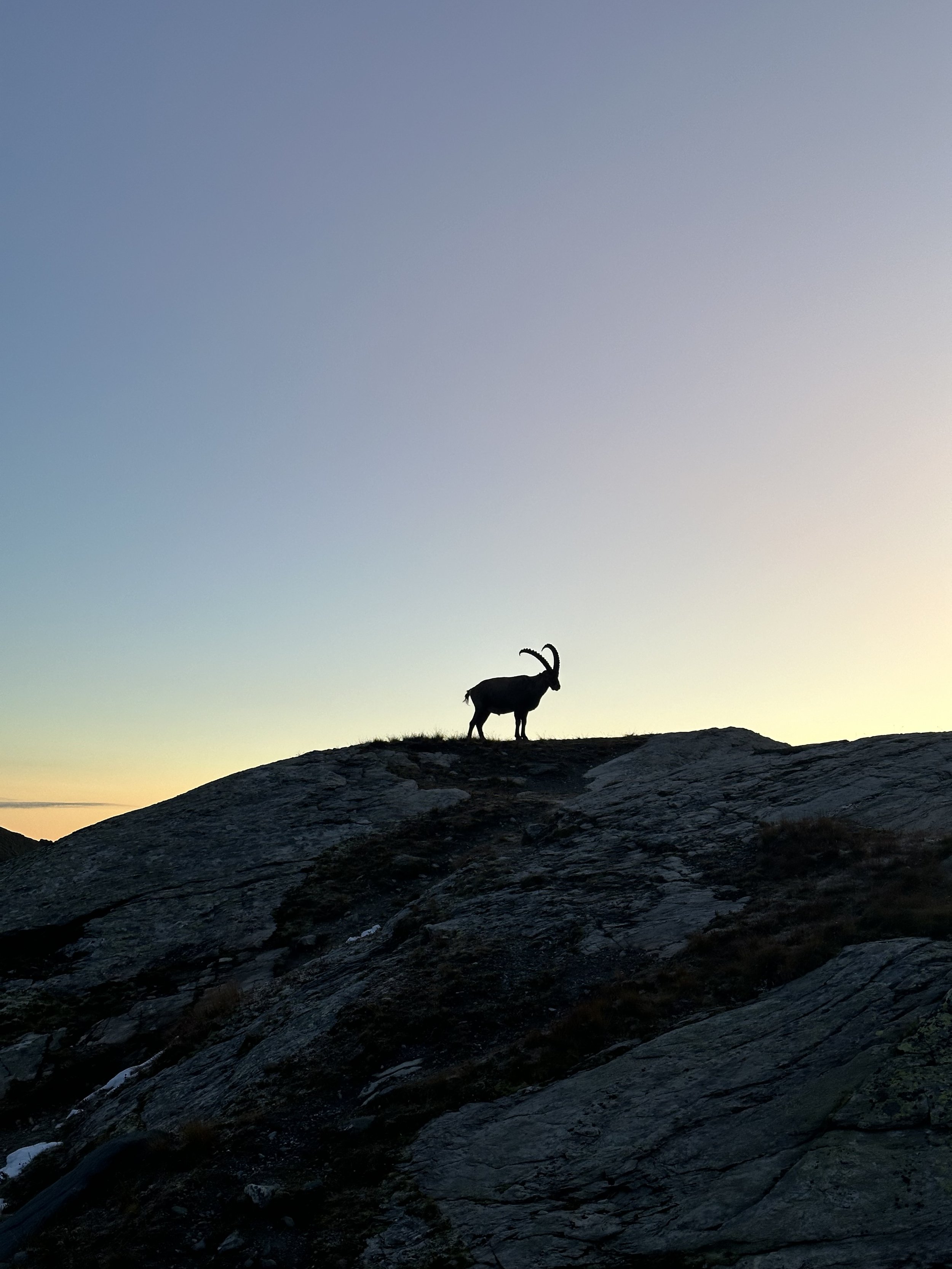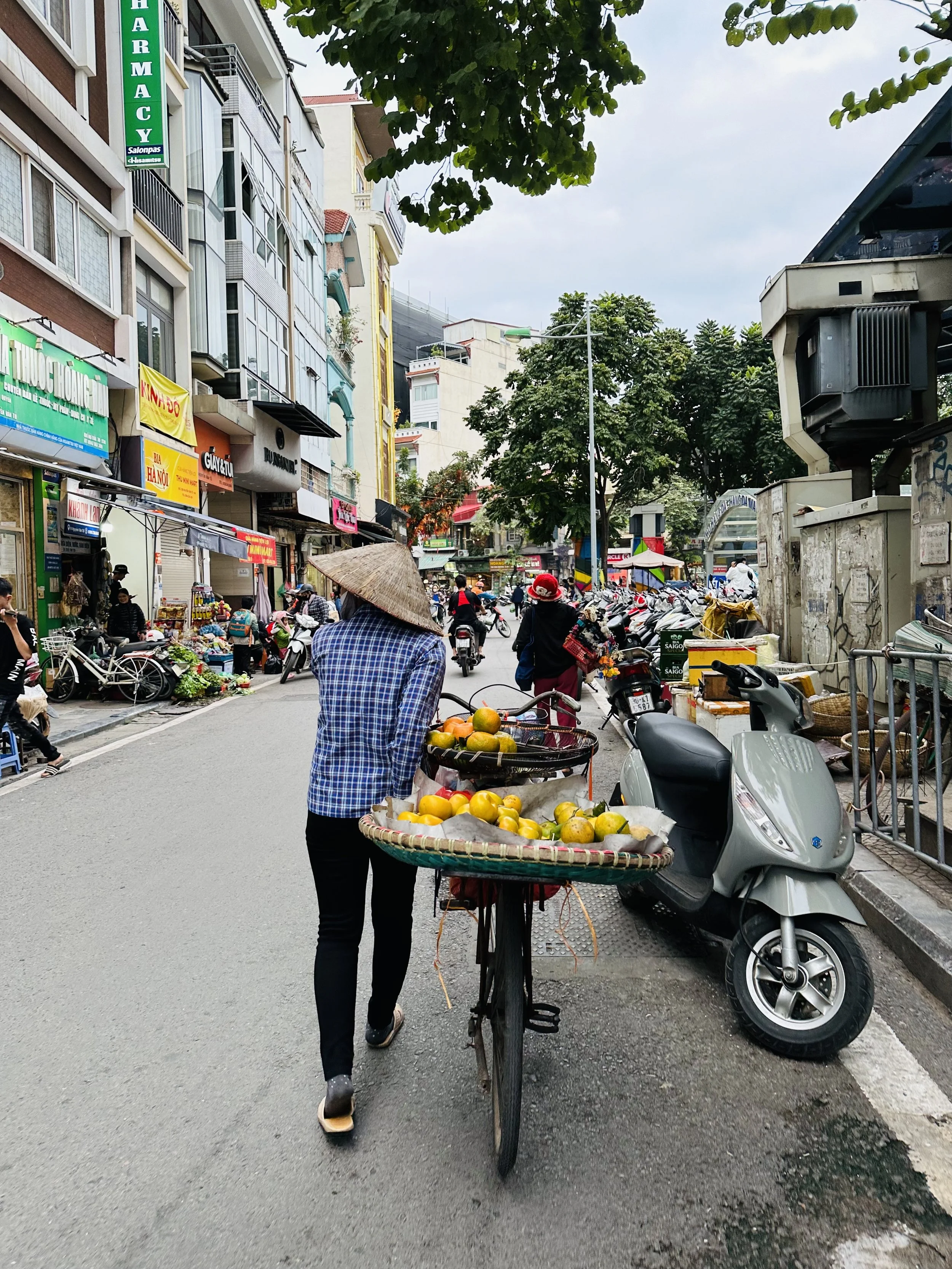My Top Ten Swiss Experiences of 2024
One of these days - one. of. these. days! - I will publish a year-end wrap in a timely manner, before we are all well into the new year. However, today it is not one of these days (shakes fist in the air).
But here we are anyway!
It’s almost unbelievable that this is my sixth “year end” installment (here’s all the posts starting from 2019). Last year’s was a bit unorthodox, as I included non-Swiss experiences, but for this post, I’m going back to the original format: Ten of my favorite Swiss experiences of 2024. It’s a long one, but half of the length is pictures (and two videos!), so I have faith that you can get through it all.
1. Winter Hut Life
I know and love summer hut life, but this year, I was introduced to its seasonal counterpart: winter hut life. Winter hut life is more or less the same as summer hut life, with the fun addition of snow, which of course, makes everything different. Same same, but different.
For my friend Hannah’s birthday, a big group of us spent a night at the Lidernenhütte in Uri. It had dumped snow in the days before, and conditions that weekend were perfect (even though the mountain road was sehr icy and it was a bit of an adventure to get everyone to the starting point). Our group was a mix of ski tourers and snowshoers, and we all made our way up from the valley to the hut in a long, winding line.
After we reached the hut, a few of the skiers snuck in a sunset tour, while the rest of the group had a late rösti lunch and hung out in the main room, sketching, writing, and chatting. All twelve of us bunked in the same room like we were having one big sleepover, and the next day, after a spectacular sunrise, we trekked up to a neighboring peak, the Hagelstock. The views of the Uri Alps from the summit were incredible, and it was so fun to experience as a group.
A night at a mountain hut is always a memorable experience, but staying at one in the winter feels extra extra special. After the freezing night sets in, no one ventures outside, and the hut becomes a snug little refuge, bustling and lively, but also somehow intimate and calm. It’s such a wintry, cozy atmosphere. Summer huts have their charm, but winter huts? Especially winter huts covered in snow with candy-cane striped shutters? Pretty magical.
(However, if you do stay at a mountain hut in winter, mentally prepare yourself for beyond icy bathroom trips. Hut bathrooms are generally in a non-heated basement, and can be frigid on a summer night, so you can imagine how a 2am pee feels in mid-January. I had to keep reminding myself “a toilet in the mountains is a luxury, a toilet in the mountains a luxury'“).
2. Anniversary weekend in Champex-Lac
Before we moved to Switzerland, Raunaq and I did not self-identify as winter people. But alas, we got married in January and then almost immediately moved to the middle of Europe - and thus have celebrated every wedding anniversary in or around the snow. We now self-identify as winter people. Or, at least Raunaq does. I’m still winter-tolerating at best.
This year, we celebrated our sixth anniversary with a weekend in the Pays du Saint-Bernard region of Valais. Our base was Champex-Lac, a picturesque village of wooden chalets all surrounding a beautiful alpine lake. Champex is an important stop on two famous long-distance treks (the Haute Route and Tour de Mont Blanc), so I think it’s one of those rare Swiss resort towns that is busier in the summer than winter. It definitely didn’t feel crowded in late January, just quaint and a little sleepy, which is always a nice atmosphere for a romantic weekend away. We stayed at the very charming Hotel Mont Lac and had such a nice time!
Originally, we planned to stay in Champex the entire weekend. There’s cross-country (with routes that cross the frozen lake), ice-skating, snowshoeing, sledding - more than enough to keep us busy. Unfortunately, snow conditions weren’t great in the village itself, so we ventured out to explore other towns in the region: Vichères, Verbier and La Fouley.
We found an amazing snowshoe trail in Vichères that ended at a wide open plateau with views of all the surrounding 4,000-meter peaks, like the Aiguille d’Argentiere and Grand Combin. In Verbier, we took the gondola to Les Ruinettes and then hiked up to Cabane Mont Fort to have lunch alongside all the bougie French skiers. I was truly in awe of the amount of fondue and wine being consumed - how do people make it down the mountain after all that?! And in La Fouley, we found one of the prettiest cross-country trails to date.
This was our first time to this part of Valais, and (with Verbier as the outlier), it all felt very low-key and local. I don’t even remember how we discovered it ourselves - I think Raunaq had a random “go to Champex” note on his phone, so someone at some point must have suggested it to us. Whoever you were, thank you! I loved it.
By the way: If you were wondering, the legendary St. Bernard avalanche rescue dogs originated (and are still bred) in this region, at the Hospice St. Bernard. And yes, apparently you can arrange to go on hikes with them!
3. May in the Shire (Ticino)
Spring in Switzerland has a truly absurd number of bank holidays. In the span of eight-ish weeks, we’ve got Good Friday, Easter Monday, Labor Day, Ascension Day, and Pentecost Monday, along with a sprinkling of regional holidays (like Sechseläuten, everyone’s favorite snowman-exploding festival). Basically, there isn’t a complete work week for about two months straight, which makes it a great time to plan some long hiking weekends.
But May is a complicated month for hiking in Switzerland - with one big exception: Ticino. Ah yes, Ticino, the Italian-speaking canton, the land of perpetual sunshine and holiday escapism, the place where spring arrives reliably early while the rest of Switzerland is shaking off winter. So to Ticino we went!
We confidently booked a few nights at the Basodino hut in the Ticinese Alps in early May - and realized about a week before our trip that the hut, and the surrounding mountains, were still covered in snow. Oops. Snowshoeing was simply out of the question (not in May, no thank you), so my friend and I scrambled to find another option. And somehow, we found the sweetest, most hidden gem of a spot, so perfect that it is hard to believe that this was the alternative plan: Agri Scinghiöra, an agriturismo tucked deep in the Valle Maggia.
I had to include a video here, even though it barely does it justice:
Now, if you are thinking, “Come on Alex, that’s not Switzerland, that’s the Shire,” then you are correct. I am certainly guilty of over-comparing different parts of this country to Middle Earth, but with no exaggeration, Agri Scinghiöra really did feel like something straight out of Lord of the Rings.
It’s in the Val Lavizzara, a remote side valley of the larger Valle Maggia. Accessible only by foot, it takes over four hours by train and bus to reach the tiny village of Brontallo, and then another steep one-hour hike from the village up to the alp. The agriturismo itself is a collection of typical Ticinese stone houses perched on the side of the mountain, with small farms scattered throughout.
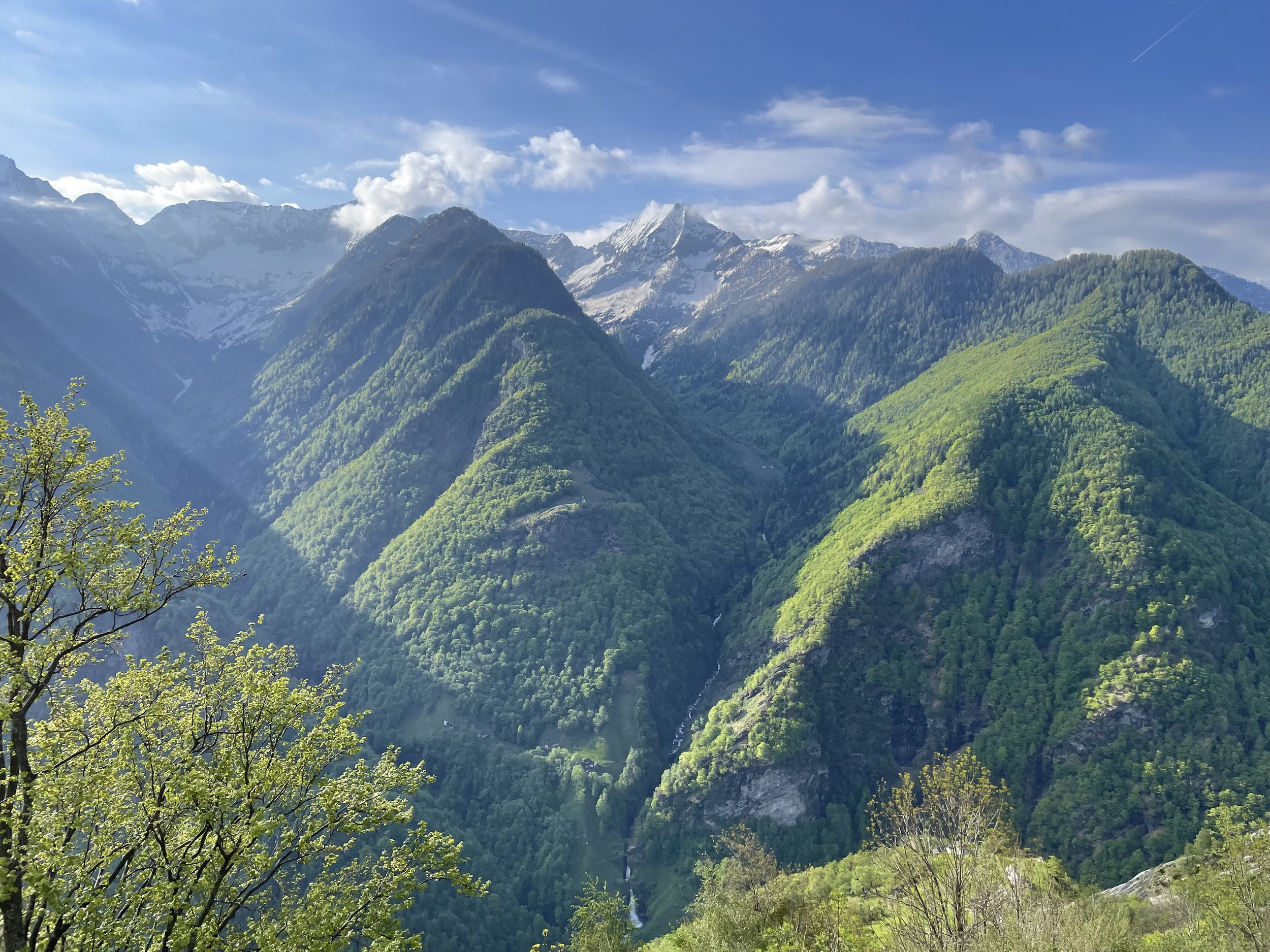
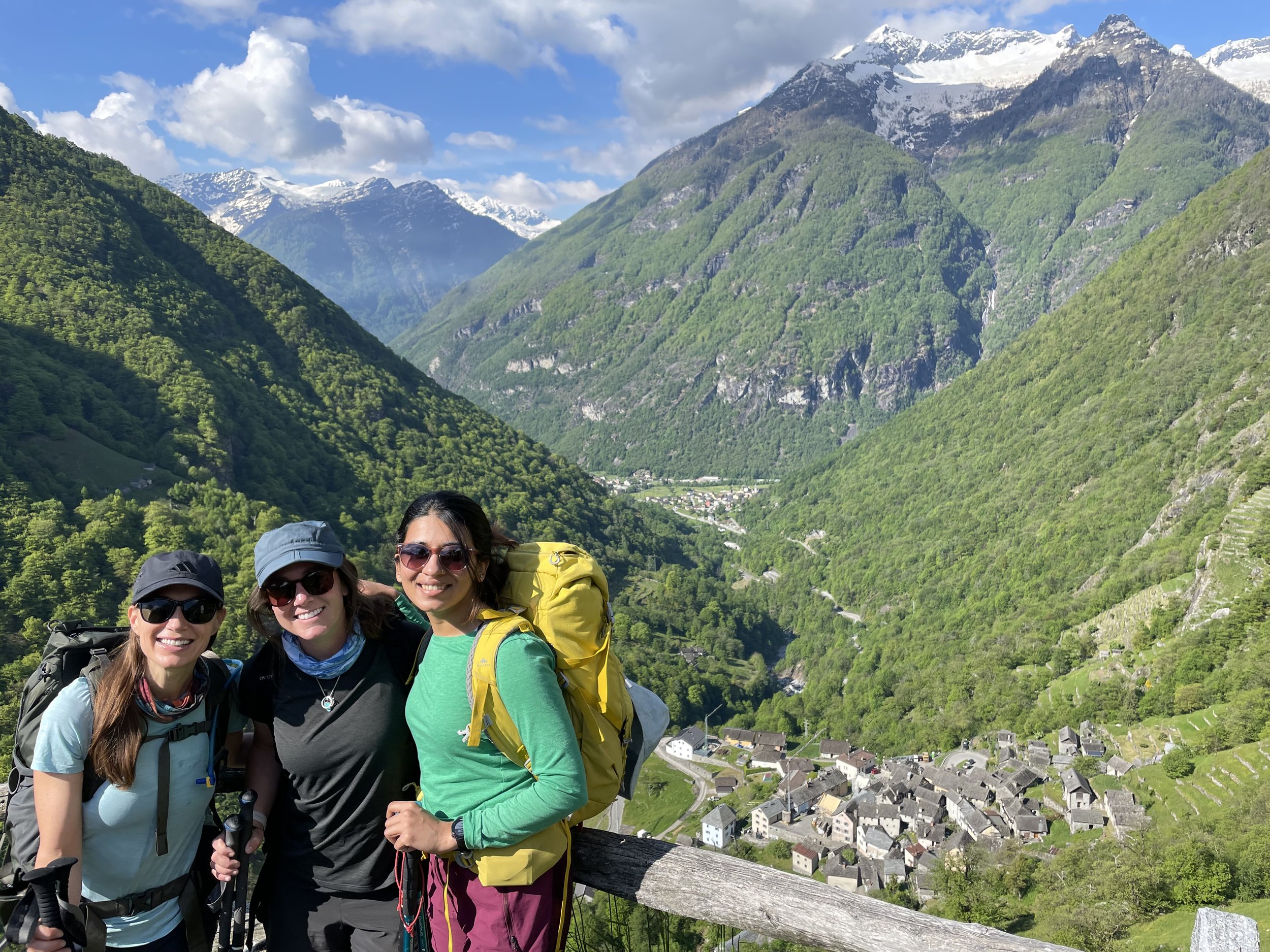
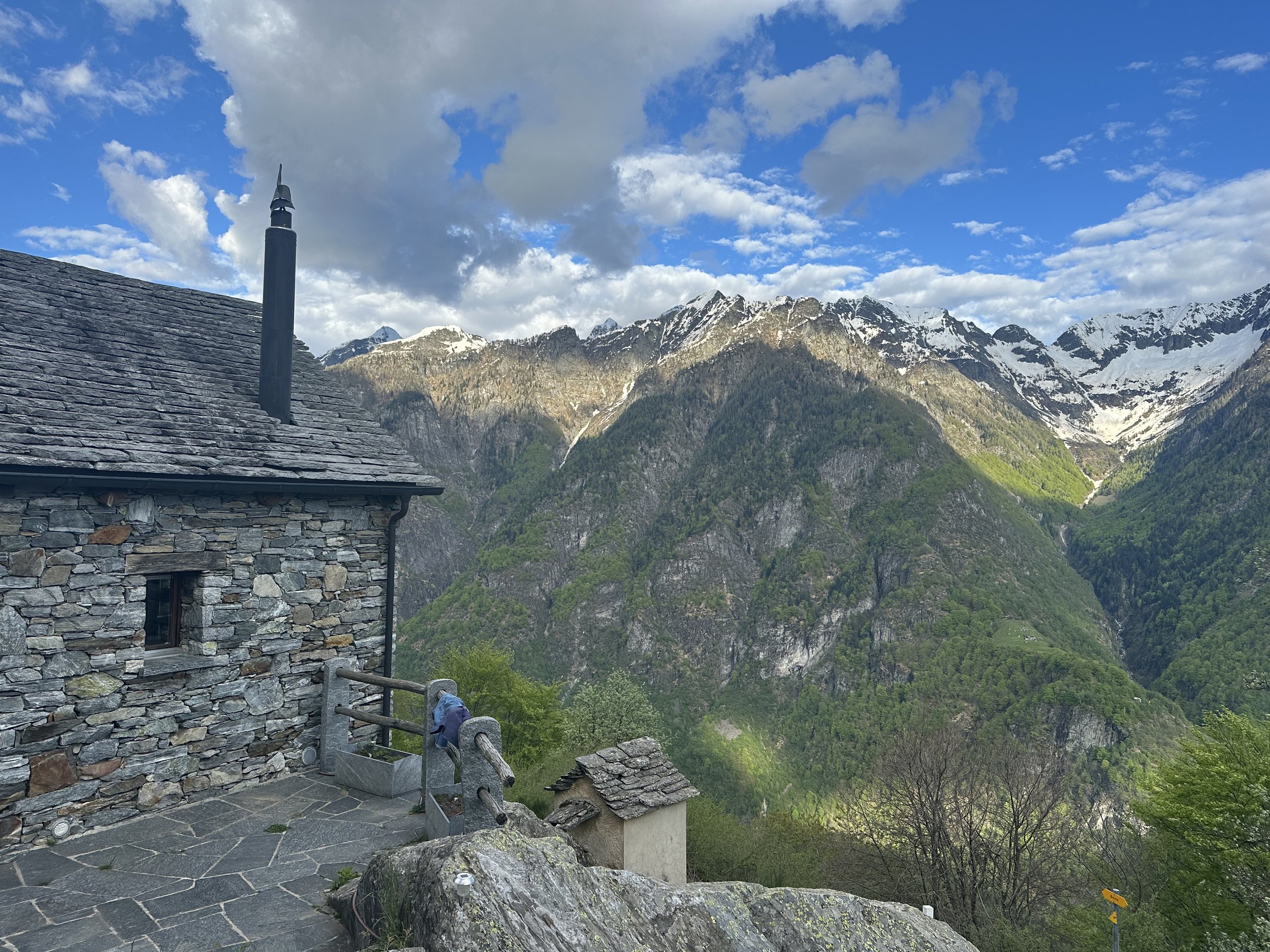
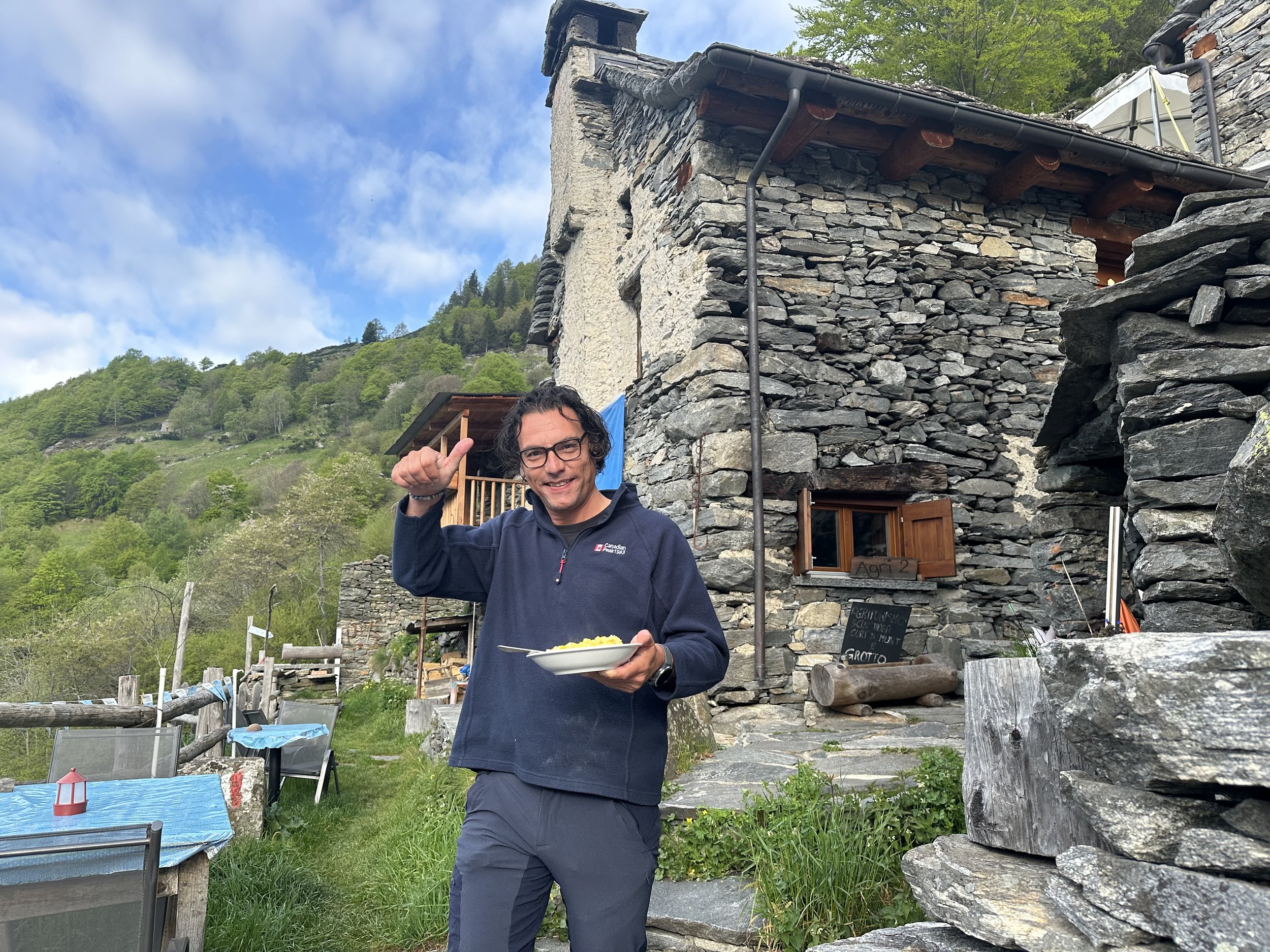
It was so charming and so quaint and simply so unexpected. We were all absolutely beside ourselves with joy when we arrived, especially when we discovered we would be staying in one of those little stone houses, and especially when we met Egon, the manager of Agri Scinghiöra. He runs most of the operation himself, and he cooked us the most incredible meals during our stay. We had dinners in the rustic farmhouse kitchen, and breakfasts out on the terrace. All the food was local from the co-op farms around Brontallo, and everything was homemade and impossibly fresh. I’m talking polenta cooked over the open fire, cheese made from that morning’s goat milk, just-baked bread, etc. I’d go back again just for the meals.
But of course, there was more than just great food. The location itself was stunning. The view from our little house, layer upon layer of forested mountains backed by snow-capped peaks, was enough to knock us off our feet. And that was just the beginning. Each day, we hiked back down to Brontallo and explored different corners of the valley. This part of Switzerland is so remote that day trips are nearly impossible, and it was a real treat to get to visit the more secluded spots that we wouldn’t normal access. We hiked to the Lago Sambuco above the hamlet of Fusio, and took very icy swims in the waterfalls pools of the Valle Prato. The weekend was so perfect, we even forgave ourselves for sleeping through the northern lights (remember when that happened?!).
Ticino always feels a bit like a fever dream, so verdant and warm and bright when the rest of the country is still gray. This little spot was like stepping into a fantasy world, and it completely stole my heart.
P.S. I don’t often gate-keep, but I was hesitant about sharing the exact location of this place. If you do get lucky enough to stay here, please treat it like the very special place it is!
4. New (Bionic!) Eyes
I got glasses in 4th grade, and switched to contact lenses the moment my parents allowed me to at 13. By 20, my prescription was so strong I was considered legally blind. I debated getting Lasik in my mid-twenties but I wasn’t a good candidate, and honestly I assumed I’d be able to rely on contacts forever (ah, the naïveté of youth). And I had a good, long run. But after 25 years of daily wear, my eyes had enough. In fall 2023, my ophthalmologist told me contact lenses were no longer an option. My choices: switch to full-time glasses, or undergo an ICL procedure.
For the uninitiated, ICL is when a surgeon makes a tiny incision into your eye, and implants an artificial lens between your natural lens and your iris. Essentially: permanent contact lenses. I know that this sounds crazy. I thought it was crazy. I’d never heard of this procedure before (even though it’s actually quite common), and I couldn’t fathom voluntarily signing up to have my eyeballs sliced open. But I also didn’t want to be tied to glasses forever. So after months of research and second opinions, I decided to go for it. I had the surgery in June of this year. I’ll save all the gory details of the procedure and recovery for another day, but it went smoothly and wasn’t nearly as scary as I thought it’d be, given the eyeball slicing and all.
This wasn’t the kind of surgery where you leave the room with perfect vision—it takes a few days to settle. The moment it really hit me, though, was on third night post-op. I was in bed, about to go to sleep, when I thought, ugh, I forgot to take out my contacts, and dragged myself to the bathroom. It was such an ingrained habit that I didn’t remember until I looked at myself in the mirror: I wasn’t wearing contacts. I could simply…see.
It’s really extraordinary. Being unencumbered by glasses or contacts for the first time in decades is freeing in way that I can’t really describe, but I know that everyone with poor vision will understand. Flying, traveling, hiking, camping, staying in huts, driving, just day to day life…it’s all so much easier. Raunaq started calling them my bionic eyes, and that’s really what it feels like. The miracle of modern medicine!
This might not sound like a Swiss experience, but, it was a life-changing experience in Switzerland, so it counts! And even though I’m familiar with the healthcare setup here, it’s still a complicated process with its own set of Swiss intricacies. Navigating the system is an achievement in of itself.
Actually, wait - there was one aspect of all this that felt distinctly Swiss: In my pre-surgery documents, there was a paragraph about how after the operation, I would be able to relax in the waiting room with a coffee and a gipfeli (croissant). Indeed, when I was done, I was handed, along with an assortment of medicated eye drops and protective sunglasses, a coffee and a gipfel.
I also still use those post-op sunglasses they gave me!
5. The Montreux Jazz Festival
This has been on Raunaq’s Swiss bucket list for years and - even though I have a well-documented aversion to (certain types of) jazz music - it’s been on my list, too. I mean, come on, I’m not a monster. The Montreux Jazz Festival is famous! Renowned! In the most beautiful music festival location in the world! And it’s not even that jazzy, as far as jazz festivals go!
We went on Friday, opening day. Trombone Shorty and Jon Batiste were the headlining acts. It was a warm summer evening, with the main stage set on the shore of Lac Léman, framed by the Swiss-French Alps in the background. You really can’t dream up a better setting.
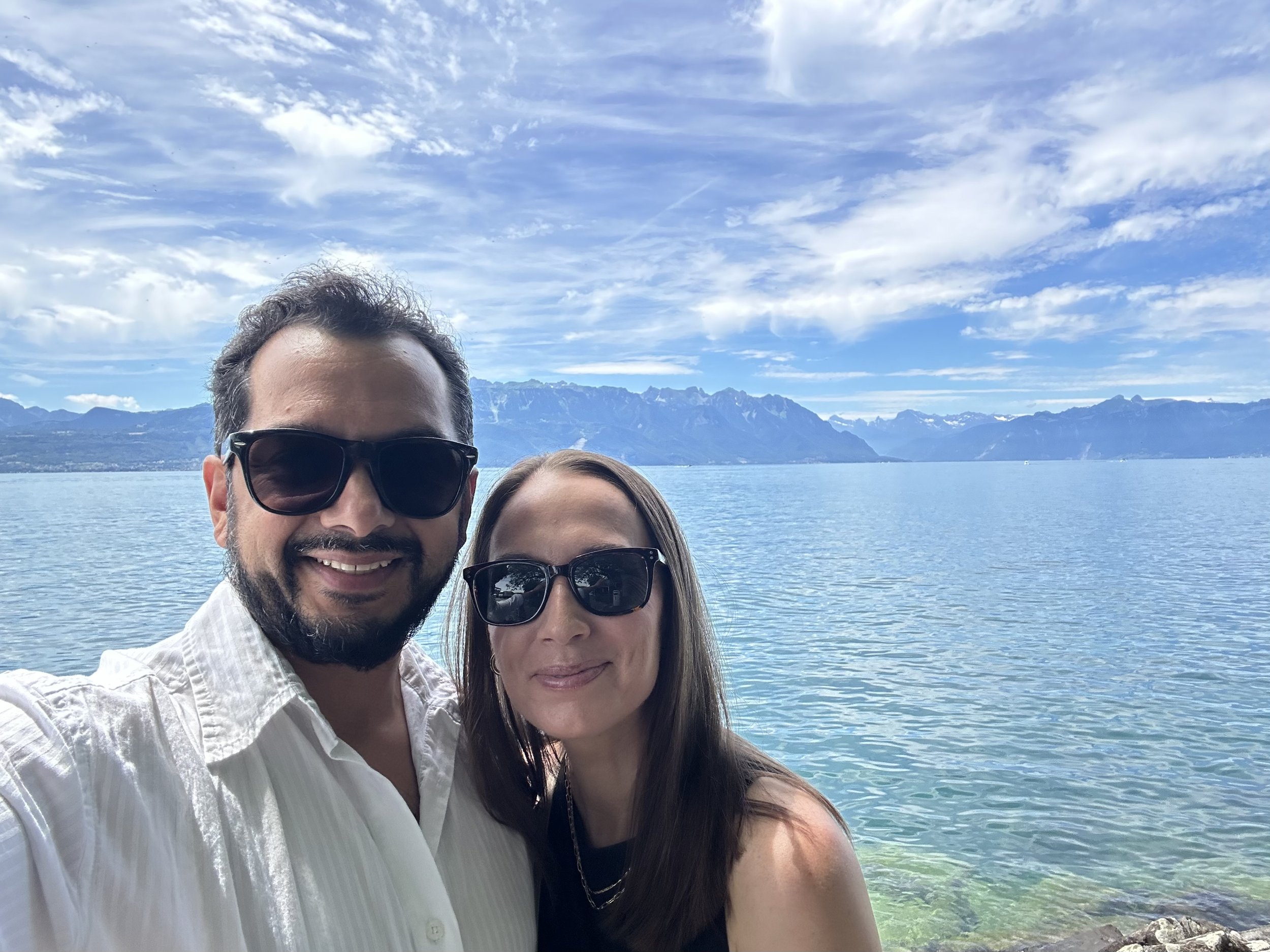
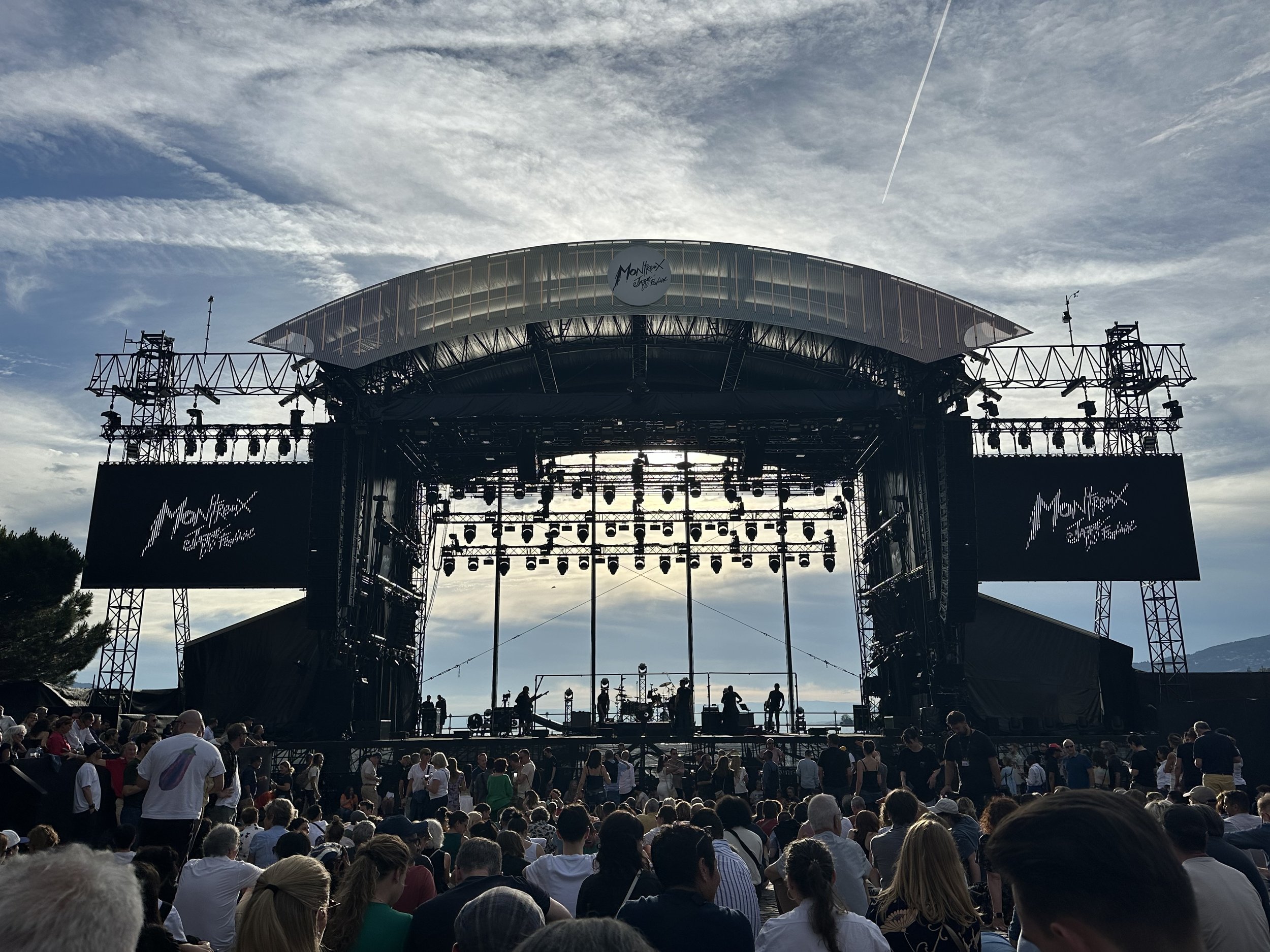
Both performances were absolutely amazing. Trombone Shorty played an incredible, energetic set as the sun went down, and Jon Batiste was completely electric. Raunaq and I were drenched in sweat after dancing our hearts out for four hours straight.
The best part came at the end of each set, when both bands paraded through the crowd with their big brass instruments N'awlins style, stopping to dance and riff off one another. Jon Batiste was literally right next to us! It was so much fun and solidified New Orleans as one of the top U.S. cities I want to visit.
(Necessary sidebar: One of the reasons we were dancing so hard is because we were doing our best to make up for the rest of the audience. The audience was, to put it nicely… dull. DULL with a capital D. Very little energy, hardly any dancing. I don’t really know how you can hear music this dynamic and not move your body. It takes more effort to stand still. It was so bad that five minutes into his set - and in the middle of his banger of a song “Freedom” - Jon Batiste stopped the music to tell the crowd that they needed to show some more energy. Yikes).
THAT SAID - all in all, it’s a great festival. There are smaller stages that ring the lake promenade, and it’s all good vibes. It’s also worth staying the night in the area, because the headlining artists often will wander around the town and do spontaneous performances on the streets or in small bars. I’d absolutely go again.
6. Moving Apartments
Our apartment on Bellariastrasse will always have a special place in my heart (here's my goodbye post), but after six years in the same flat, both Raunaq and I were ready for a change. It was a long, rough search with many rejected applications (the apartment hunt in Zurich is not for the weak), but we finally found an apartment that checked all of our boxes. Even, it turned out, the boxes that we didn’t know we had, like an en-suite bathroom with a Japanese-style toilet, and a kitchen equipped with a wine fridge.
I resisted the concept of living in a “modern” apartment for a long time. I love the personality of older places, the charm that’s found in all the different nooks and crannies. Newer buildings, especially in Switzerland, always struck me as flat and lifeless. “I just don't want to live in a box,” I would say to Raunaq. But alas, even the most fervent believer can be swayed. And yes, now we live in a modern apartment, and yes, it’s a box, and yes, I’m still very happy about it. We just had to bring the personality with us.
It took a few weeks and a few IKEA trips to get settled, but now, this new place feels like home.
Moving within Switzerland is, as to be expected, a completely different experience from moving within U.S. And perhaps what was most Swiss about this experience was managing the “pre-move” purge. In California, I’d just pack up my car and drop everything - literally everything - at a Goodwill. I’m not saying this is as a positive, but in America, convenience is king, and it is extremely easy to get rid of things.
Here, it is…well. A little more complicated. While there are thrift stores in Zurich, they’re notoriously selective about what they’ll accept. Donation centers, like Salvation Army, also have fairly stringent standards. I quickly learned that getting rid of unwanted items involves sorting everything by category and taking it to different places around the city. Spreadsheets were involved.
For example, old electronics can be dropped off at the closest E-tram station once a month. What’s the E-tram? It’s an old tram that runs on the same tracks as the normal city trams, but instead of picking up people, it picks up old toasters and keyboards and hairdryers. Bulky items, like small pieces of furniture? Good news, there is also a cargo tram. Bigger items that aren’t accepted by the cargo tram can be dropped off, for a fee, at a recycling center on the outskirts of the city. They charge you by the weight of the items, and guess how they weigh everything? They weigh your car when you drive into the center, and again when you drive out, then calculate the difference! Clothes and shoes can be put in the public textile donation bins that are in every neighborhood. And so on, and so on. Got it?
It became a bit of a game for me. How well I could match up our unwanted items with the appropriate collection center? I was fairly successful, although I did have to resort to leaving some items on the curb (the classic “gratis” box). But I could only do so in the middle of the night, dressed in all black and under the cover of darkness, because oh, the shame.
The final step of moving is enduring the infamous apartment handover process, another Swiss rite of passage. This is when the landlord inspects every centimeter of your flat to ensure it is pristine condition for the text tenant (some literally put on white gloves to check the cleanliness😱). I have heard many horror stories about this and was dreading it, although we got through relatively unscathed. But let’s just say I’ll be fine with not moving for another six years.
7. Our own little mountain getaway
On a bit of a whim, we decided to share a sublet on a holiday apartment in the Davos area. Starting in June, we had the apartment every other week. I was a little unsure at first—I’ve always enjoyed exploring different parts of Switzerland, and wondered how I’d feel spending so much time in the same place. But it turned out to be the best little getaway.
The location was a gateway to Eastern Switzerland, and we took full advantage of this opportunity to explore the region. In the summer, we hiked throughout Graubünden, using our apartment as a jumping off point to get deeper into the canton, to the Lower Engadine, Upper Engadine, Parc Ela, and all the way to the border of Italy. In the fall, I fully immersed myself in larch season, spending as much time with my beloved trees as I could ever have wanted. And winter has only just begun, but I’ll say it’s looking good so far.
And the apartment itself? It’s nothing fancy - it’s small, rustic, and up a big hill that our car can’t drive up. But it’s a sweet little place that has everything we need. There are cows and chickens outside our window in the summer, along with a gaggle of turkeys that enjoy terrorizing me (Raunaq insists that they are just trying to be friendly, but I have serious doubts). In the winter, we sled down the long driveway because it’s the fastest way down. We buy our eggs and milk and cheese from the local farmers. Naturally, we became regulars at the local sauna. And I remembered that while there’s so much excitement in exploring new places, there’s also the quiet joy in watching something new grow into something familiar.
8. A Swiss-only summer
Raunaq and I did less international travel this year than any other in Switzerland. Which isn’t to say we didn’t travel at all. I went on a once-in-a-lifetime trip to Japan with six of my college best friends to celebrate 20 years of friendship. Raunaq and I spent spring break in Corsica, and we also did weekend trips to Berlin, London, and Copenhagen. The Copenhagen trip was particularly significant because our first date was on June 10, 2014 at a Mikkeller bar in San Francisco. So, we had a beer on June 10, 2024 at the original Mikkeller brewery in Copenhagen to toast the first decade of our relationship (cute, right?).
But for most of the year, we stayed put. Notably, Raunaq and I did not leave Switzerland for three straight months: July, August, and September. It was an anomaly, to be sure.
But it was an anomaly by design. Health-wise, I had a rough spring, and I needed time to let myself recover. Second, as #6 and #7 on this list show, we had a new apartment and a new mountain home to enjoy. Raunaq was coming off a hectic few months filled with work travel. And both of us were happy to simply slow our lives down a bit.
We did all of our favorite Zuri summer activities, like outdoor movies and morning badi trips and Street Parade (even if we only lasted an hour among the youths). We spent a lot of time hiking. We stayed at some incredible huts. We did lots of lake swimming, and I got more use out of my paddleboard than the previous summers combined. I savored the quiet pleasure of routine, and sank into the rhythm of daily life. It was so nice to just enjoy being in Switzerland, which, as I’ve stated previously, is Europe’s best summer secret. I even completely forgot where my passport was (but don’t worry, it was found!).
But most of all, this became a season of grounding. It didn’t take long for me to realize that what I truly needed wasn’t just physical recharge, but also a mental and emotional one. The first six months of the year were tough. A cascade of different things - my health, my work, homesickness for family and friends, a full-blown identity crisis - had collided in a way that made me question whether Switzerland was still the right place for me. I felt unmoored, like somewhere along my way I had missed a turn and was now lost. It was confusing and unsettling.
This three-month pause gave me some space. Space to breath, reflect, recalibrate, and ultimately, to sit with those difficult questions and do some soul-searching. Staying put turned out to be its own kind of adventure, one where the destination wasn’t a place but a state of mind: one of contentment, clarity and reconnection. This pause helped affirm that yes, even though I wanted to make some changes, that this is where I want to be.
9. The alpine passes of Valais
In September, Raunaq and I hiked five stages of the Alpine Passes Trail. Five days of high-alpine hiking, four nights in remote mountain huts, and some of the most beautiful landscapes I’ve ever seen. This was my first big hut-to-hut tour in Switzerland, and let’s just say that it set the bar extremely high for any trek that follows. I already wrote extensively about the whole hike here, so I’ll just share some of my favorite photo highlights:
Beyond the scenery, what made this hike really special was how quiet everything was. I had only ever stayed in huts on weekends, when they’re bustling with activity and packed to capacity. Saturday nights are lively, sociable, and fun, but staying on a weekday—especially in September—offered a completely different experience. On our first night at Cabane des Dix, there were only six of us in a hut built to sleep 90. This pattern repeated over the next three nights, creating a relaxed and intimate atmosphere that made it easier to connect with the surroundings. AND - it also meant that Raunaq and I got our own rooms every night, which is such a luxury. I actually was able to get pretty decent sleep!
10. Fear and what comes after
I hope you made it all the way to this last one, because this was my most important experience at all.
For years, I battled a fear of heights. And this was the year that I finally, finally, faced it. There were lots of little victories along the way, and one big, notable breakthrough. It was completing my first T4 alpine trail, a type of trail that I had previously been too nervous to try. This one was even more exposed than I anticipated. But I felt strong and confident, and yes, a little scared, but I didn’t let it rattle me and most importantly, I didn’t let it stop me. I even, dare I say, had fun with it. At the top, I felt like a freaking superhero.
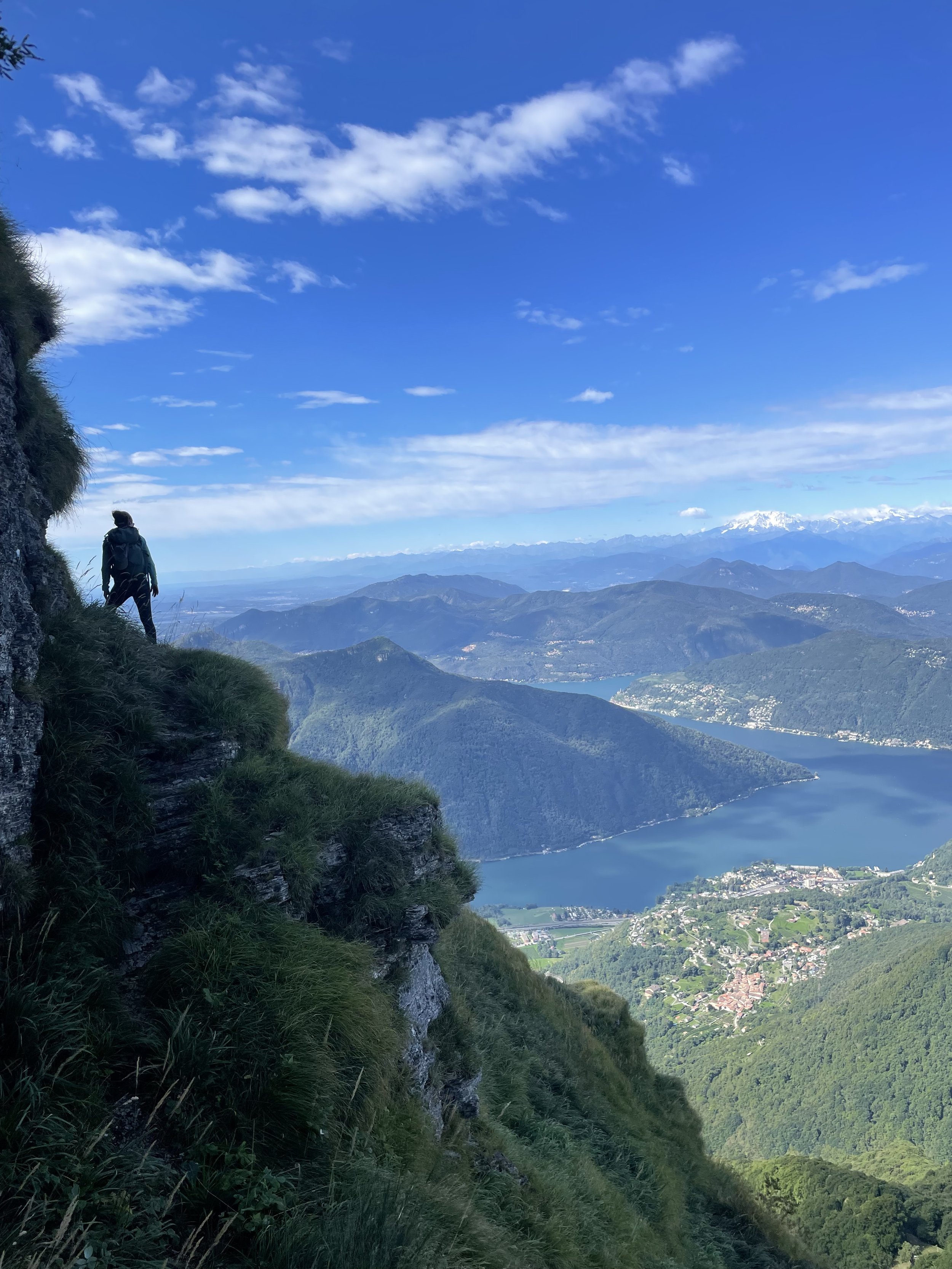
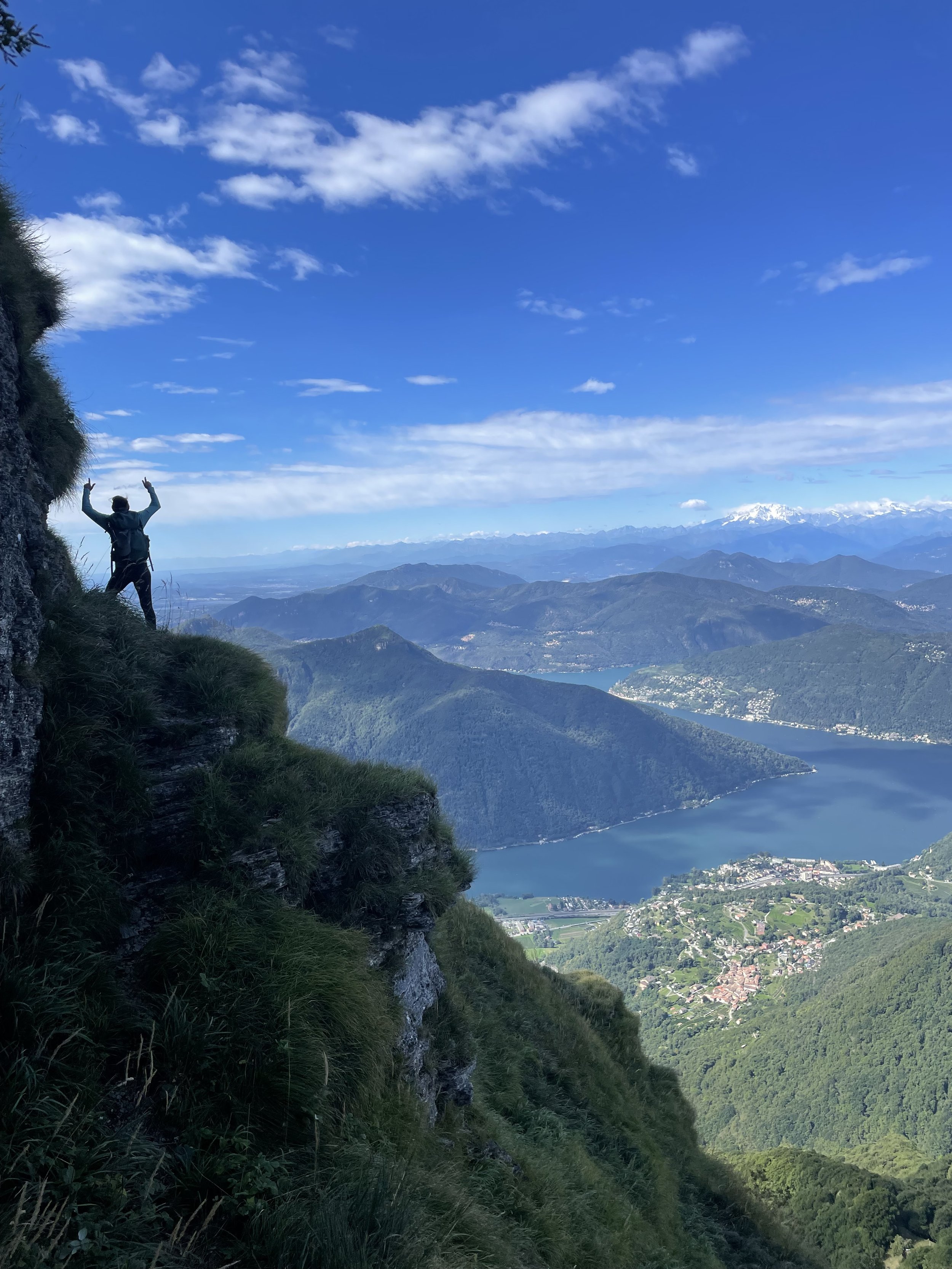
But it was more than just an endorphin rush. That moment was transformative for me, not just as a hiker, but as a person. Because on that mountain, something in my mind unlocked. I did the thing that scared me the most, and I survived it. So… what else can I do? What else can I do? Anything.
The shift felt instantaneous, magical, almost too easy - although I knew it was anything but. It was the result of so much effort and work leading up to this moment. This moment when the door to the cage I had locked myself in, the cage built from my own limiting beliefs and anxieties and fears, swung open. And all of a sudden, I was free.
I know that sounds a bit dramatic. Probably very dramatic. But honestly, I don’t know how else to say it, because truly, it felt dramatic. No - it felt seismic. And you know what? I don’t care if it comes off as cringey, self-helpy, or completely over-the-top. I don’t care because I want to shout it from the rooftops: I’m free. I’m free from the cage of being afraid, and I refuse to go back. It’s an entirely new world
A friend of mine recently mentioned a concept from a book called Hidden Potential that feels relevant. The idea is that stepping away from a challenge to do something entirely different can help you return to the original task with renewed focus and energy. For example, a basketball player might climb Kilimanjaro and come back more inspired and determined in their sport. Though my experience isn’t quite the same, the underlying principle resonates. Sometimes, it’s the act of confronting something unexpected that gives us the clarity and courage to redefine who we are.
Just days after completing that hike, I sent out my first inquiries for a project idea that had been bubbling in my mind. It’s a big, exciting, and admittedly daunting endeavor—one that combines my interests here in Switzerland with issues I’m deeply passionate about. It’s a project that I thought would be too difficult to make a reality. And it might be. But in this new world of mine, I have the confidence to find out.
2025 might be the year that big ideas come to life (Or hey, it could be the year that I fail most spectacularly. We’ll find out). But 2024? 2024 was the year I stopped being afraid to try. And that’s pretty cool.
Honorable mentions (aka my loophole to add in more little things I loved about this year):
Everything about our two days on the Greina Plateau.
Hitching a ride down a mountain with a farmer and his pregnant cow.
Celebrating my first Thanksgiving in seven (!) years, and my first “expat” Thanksgiving ever. And let me tell you, the flavors of the food were so nostalgic, it made me cry.
Lead climbing! I took a course in February, bought myself a rope, and now voluntarily (and enjoyably) hang off 17-meter high walls.
The most iconic start to the holiday season, when the first snow coincided with the opening of the Christmas markets.
Hosting our first party in our new apartment (without getting the cops called on us!).
This post is always my most intimidating to write.
I know it’s going to be hard to narrow down to ten experiences (an arbitrary number I decided on six years ago, and now feel like I can’t change, for sake of tradition). I know that it’s going to take a long time to write (every January, I tell myself that I’m going to write this bit by bit throughout the year, and every December, I find myself staring at a blank page). And I know that it’s going to involve a lot of self-reflection (which, though a valuable practice, can always bring up some tough emotions).
But it’s also my favorite post to write.
I love having each year of my Swiss life catalogued (365 days neatly encapsulated into ten distinct vignettes). I love the process of writing it out (and stitching together all the Frankenstein bits and pieces into one coherent story). And mostly, I love what I learn (both about myself and my personal journey, as well as the broader lessons about values, people, and the world around me).
Thanks for sticking with me so far, and I hope you’ll stick around to see what’s next. Happy new year!


